OpenStack Projects For WHMCS
(→Quota Configuraton Guide) |
(→Tips) |
||
| (42 intermediate revisions by 2 users not shown) | |||
| Line 1: | Line 1: | ||
<meta name="keywords" content="<meta name="keywords" content="openstack projects for whmcs, openstack projects configuration, whmcs openstack projects management, whmcs openstack projects installation, whmcs openstack projects common problems, about whmcs openstack projects, whmcs openstack projects documentation, whmcs openstack projects faq, whmcs openstack projects help, whmcs openstack projects guide, whmcs openstack projects wiki, whmcs openstack projects tutorial, whmcs openstack projects tips, whmcs openstack projects wiki"> | <meta name="keywords" content="<meta name="keywords" content="openstack projects for whmcs, openstack projects configuration, whmcs openstack projects management, whmcs openstack projects installation, whmcs openstack projects common problems, about whmcs openstack projects, whmcs openstack projects documentation, whmcs openstack projects faq, whmcs openstack projects help, whmcs openstack projects guide, whmcs openstack projects wiki, whmcs openstack projects tutorial, whmcs openstack projects tips, whmcs openstack projects wiki"> | ||
<meta name="description" content="ModulesGarden Wiki Contains All The Information You Need About The OpenStack Projects For WHMCS Module."></meta> | <meta name="description" content="ModulesGarden Wiki Contains All The Information You Need About The OpenStack Projects For WHMCS Module."></meta> | ||
| − | |||
| − | |||
| − | |||
| − | |||
| − | |||
| − | |||
| − | |||
=About [https://www.modulesgarden.com/products/whmcs/openstack-projects OpenStack Projects For WHMCS]= | =About [https://www.modulesgarden.com/products/whmcs/openstack-projects OpenStack Projects For WHMCS]= | ||
| Line 61: | Line 54: | ||
|} | |} | ||
{| | {| | ||
| − | |style="padding: 0px 0px 0px 45px;"|✔ Define User Roles | + | |style="padding: 0px 0px 0px 45px;"|✔ Define Project User Roles |
|} | |} | ||
{| | {| | ||
| Line 194: | Line 187: | ||
*'''Configurable Options:''' | *'''Configurable Options:''' | ||
{| | {| | ||
| − | |style="padding: 10px 0px 0px 30px;"|✔ | + | |style="padding: 10px 0px 0px 30px;"|✔ Backups |
|} | |} | ||
{| | {| | ||
| − | |style="padding: 0px 0px 0px 30px;"|✔ | + | |style="padding: 0px 0px 0px 30px;"|✔ Bandwidth Limit |
| + | |} | ||
| + | {| | ||
| + | |style="padding: 0px 0px 0px 30px;"|✔ Bandwidth Limit Rules - Max Egress (kbps) | ||
| + | |} | ||
| + | {| | ||
| + | |style="padding: 0px 0px 0px 30px;"|✔ Bandwidth Limit Rules - Max Egress Burst (kbps) | ||
| + | |} | ||
| + | {| | ||
| + | |style="padding: 0px 0px 0px 30px;"|✔ Bandwidth Limit Rules - Max Ingress (kbps) | ||
| + | |} | ||
| + | {| | ||
| + | |style="padding: 0px 0px 0px 30px;"|✔ Backundwidth Limit Rules - Max Ingress Burst (kbps) | ||
|} | |} | ||
{| | {| | ||
|style="padding: 0px 0px 0px 30px;"|✔ Cores | |style="padding: 0px 0px 0px 30px;"|✔ Cores | ||
| + | |} | ||
| + | {| | ||
| + | |style="padding: 0px 0px 0px 30px;"|✔ Endpoint Group | ||
|} | |} | ||
{| | {| | ||
| Line 222: | Line 230: | ||
{| | {| | ||
|style="padding: 0px 0px 0px 30px;"|✔ Health Monitor | |style="padding: 0px 0px 0px 30px;"|✔ Health Monitor | ||
| + | |} | ||
| + | {| | ||
| + | |style="padding: 0px 0px 0px 30px;"|✔ Ike Policy | ||
|} | |} | ||
{| | {| | ||
| Line 234: | Line 245: | ||
{| | {| | ||
|style="padding: 0px 0px 0px 30px;"|✔ Instances | |style="padding: 0px 0px 0px 30px;"|✔ Instances | ||
| + | |} | ||
| + | {| | ||
| + | |style="padding: 0px 0px 0px 30px;"|✔ IPsec Policy | ||
| + | |} | ||
| + | {| | ||
| + | |style="padding: 0px 0px 0px 30px;"|✔ IPsec Site Connection | ||
|} | |} | ||
{| | {| | ||
| Line 251: | Line 268: | ||
|} | |} | ||
{| | {| | ||
| − | |style="padding: 0px 0px 0px 30px;"|✔ | + | |style="padding: 0px 0px 0px 30px;"|✔ Minimum Bandwidth |
|} | |} | ||
{| | {| | ||
| − | |style="padding: 0px 0px 0px 30px;"|✔ | + | |style="padding: 0px 0px 0px 30px;"|✔ Minimum Bandwidth Rates Rules - Min Egress (kbps) |
|} | |} | ||
{| | {| | ||
| − | |style="padding: 0px 0px 0px 30px;"|✔ | + | |style="padding: 0px 0px 0px 30px;"|✔ Minimum Bandwidth LimitRate Rules - Min Ingress (kbps)< |
|} | |} | ||
{| | {| | ||
| − | |style="padding: 0px 0px 0px 30px;"|✔ | + | |style="padding: 0px 0px 0px 30px;"|✔ Network |
|} | |} | ||
{| | {| | ||
| − | |style="padding: 0px 0px 0px 30px;"|✔ | + | |style="padding: 0px 0px 0px 30px;"|✔ Per Volume Gigabytes |
|} | |} | ||
{| | {| | ||
| − | |style="padding: 0px 0px 0px 30px;"|✔ | + | |style="padding: 0px 0px 0px 30px;"|✔ Pool |
| + | |} | ||
| + | {| | ||
| + | |style="padding: 0px 0px 0px 30px;"|✔ Port | ||
|} | |} | ||
{| | {| | ||
| Line 279: | Line 299: | ||
{| | {| | ||
|style="padding: 0px 0px 0px 30px;"|✔ Security Group | |style="padding: 0px 0px 0px 30px;"|✔ Security Group | ||
| + | |} | ||
| + | {| | ||
| + | |style="padding: 0px 0px 0px 30px;"|✔ Security Group Device | ||
|} | |} | ||
{| | {| | ||
| Line 308: | Line 331: | ||
|} | |} | ||
{| | {| | ||
| − | |style="padding: 0px 0px | + | |style="padding: 0px 0px 0px 30px;"|✔ Volumes |
| + | |} | ||
| + | {| | ||
| + | |style="padding: 0px 0px 10px 30px;"|✔ VPN Service | ||
|} | |} | ||
| Line 325: | Line 351: | ||
{| | {| | ||
|style="padding: 0px 0px 0px 30px;"|✔ Multi-Language Support | |style="padding: 0px 0px 0px 30px;"|✔ Multi-Language Support | ||
| + | |} | ||
| + | {| | ||
| + | |style="padding: 0px 0px 0px 30px;"|✔ Supports All Providers That Grant Access To OpenStack API On System Admin Level | ||
|} | |} | ||
{| | {| | ||
| Line 336: | Line 365: | ||
|} | |} | ||
{| | {| | ||
| − | |style="padding: 0px 0px 0px 30px;"|✔ | + | |style="padding: 0px 0px 0px 30px;"|✔ PHP 8.2 Back To PHP 8.1 |
|} | |} | ||
{| | {| | ||
| − | |style="padding: 0px 0px 0px 30px;"|✔ Supports WHMCS Metric Billing - Integration: CPU, Compute Instance Booting Time, Disk Device Read Bytes, Disk Device Read Requests, Disk Device Write Bytes, Disk Device Write Requests, Disk Ephemeral Size, Disk Root Size, Floating IP Addresses, IP Addresses, Load Balancers, Memory, Memory Usage, Network Incoming Bytes, Network Incoming Packets, Network Outgoing Bytes, Network Outgoing Packets, OS | + | |style="padding: 0px 0px 0px 30px;"|✔ Supports WHMCS Metric Billing - Integration: CPU, Compute Instance Booting Time, Custom Floating IP Addresses, Custom IP Addresses, Custom Network Incoming Bytes, Custom Network Incoming Packets, Custom Network Outgoing Bytes, Custom Network Outgoing Packets, Default Storage, Disk Device Read Bytes, Disk Device Read Requests, Disk Device Write Bytes, Disk Device Write Requests, Disk Ephemeral Size, Disk Root Size, Floating IP Addresses, IP Addresses, Image Size, Load Balancers, Memory, Memory Usage, Network Incoming Bytes, Network Incoming Packets, Network Outgoing Bytes, Network Outgoing Packets, OS ImagesSnapshot Size, VCPUs, Volume Size, VolumResources OS VCPU Usage, Resources SSD |
|} | |} | ||
{| | {| | ||
| Line 345: | Line 374: | ||
|} | |} | ||
{| | {| | ||
| − | |style="padding: 0px 0px 0px 30px;"|✔ Supports WHMCS V8. | + | |style="padding: 0px 0px 0px 30px;"|✔ Supports WHMCS V8.12 Back To WHMCS V8.9 |
|} | |} | ||
{| | {| | ||
| − | |style="padding: 0px 0px 0px 30px;"|✔ Requires ionCube Loader | + | |style="padding: 0px 0px 0px 30px;"|✔ Requires ionCube Loader V14 Or Later |
|} | |} | ||
{| | {| | ||
| Line 388: | Line 417: | ||
|style="padding: 0px 0px 20px 25px;"|[[File:OSP_4.png]] | |style="padding: 0px 0px 20px 25px;"|[[File:OSP_4.png]] | ||
|} | |} | ||
| − | {| | + | <!--{| |
|style="padding: 0px 0px 15px 15px;"|'''5. Now, set up the '' 'storage' '' folder as recursively writable.'''<br /> | |style="padding: 0px 0px 15px 15px;"|'''5. Now, set up the '' 'storage' '' folder as recursively writable.'''<br /> | ||
This folder is available at '' '/yourWHMCS/modules/servers/OpenStackProjects/'. '' | This folder is available at '' '/yourWHMCS/modules/servers/OpenStackProjects/'. '' | ||
| Line 394: | Line 423: | ||
{| | {| | ||
|style="padding: 0px 0px 20px 25px;"|[[File:OSP_5.png]] | |style="padding: 0px 0px 20px 25px;"|[[File:OSP_5.png]] | ||
| − | |} | + | |}--> |
{| | {| | ||
| − | |style="padding: 0px 0px 15px 15px;"|''' | + | |style="padding: 0px 0px 15px 15px;"|'''5. Now you have to activate the module in your WHMCS system.'''<br /> |
Log in to your WHMCS administrator area. Go to '' 'System Settings' '' → '' 'Addon Modules'. ''<br /> | Log in to your WHMCS administrator area. Go to '' 'System Settings' '' → '' 'Addon Modules'. ''<br /> | ||
Afterwards, find '' 'OpenStack Projects' '' and press '' 'Activate' '' button. | Afterwards, find '' 'OpenStack Projects' '' and press '' 'Activate' '' button. | ||
| Line 404: | Line 433: | ||
|} | |} | ||
{| | {| | ||
| − | |style="padding: 0px 0px 15px 15px;"|''' | + | |style="padding: 0px 0px 15px 15px;"|'''6. In the next step, you need to permit access to the module.'''<br /> |
To do so, click on the'' 'Configure' '' button, select administrator groups that should have access to this addon and press '' 'Save Changes'. '' | To do so, click on the'' 'Configure' '' button, select administrator groups that should have access to this addon and press '' 'Save Changes'. '' | ||
|} | |} | ||
| Line 411: | Line 440: | ||
|} | |} | ||
{| | {| | ||
| − | |style="padding: 0px 0px 15px 15px;"|''' | + | |style="padding: 0px 0px 15px 15px;"|'''7. Finally, set up the cron command line provided below and define its frequency (1 minute interval is suggested).''' |
php -q /yourWHMCS/modules/servers/OpenstackProjects/cron/cron.php queue | php -q /yourWHMCS/modules/servers/OpenstackProjects/cron/cron.php queue | ||
This enables tasks such as '' 'suspend resources,' '' '' 'unsuspend resources,' '' '' 'terminate resources,' '' and '' 'lock account' '' to queue and run. | This enables tasks such as '' 'suspend resources,' '' '' 'unsuspend resources,' '' '' 'terminate resources,' '' and '' 'lock account' '' to queue and run. | ||
|} | |} | ||
{| | {| | ||
| − | |style="padding: 0px 0px 30px 15px;"|''' | + | |style="padding: 0px 0px 30px 15px;"|'''8. You have just successfully installed OpenStack Projects For WHMCS!'''<br /> |
You can access your module under '' 'Addons' '' → '' 'OpenStack Projects'. '' | You can access your module under '' 'Addons' '' → '' 'OpenStack Projects'. '' | ||
|} | |} | ||
| Line 434: | Line 463: | ||
|} | |} | ||
{| | {| | ||
| − | |style="padding: 0px 0px 20px 15px;"|''' | + | |style="padding: 0px 0px 20px 15px;"|'''9. Now, log in to your WHMCS and proceed to '' 'System Settings' '' → '' 'Products/Services' '' → '' 'Servers' '' and press '' 'Add New Server'.'' |
|} | |} | ||
{| | {| | ||
| Line 440: | Line 469: | ||
|} | |} | ||
{| | {| | ||
| − | |style="padding: 0px 0px 15px 15px;"|''' | + | |style="padding: 0px 0px 15px 15px;"|'''10. Next, enter your server '' 'Name' '', '' 'Hostname' '', '' 'IP Address' '' and select '' 'Openstack Projects' '' from the '' 'Module' '' field.'''<br/> |
| − | Now, provide your '' 'OpenStack Server Details' ''. To download the '' 'Identity Version' '', you need to click '' 'Get Versions' '' next to '' 'Identity Port/Path' '' . <br/> Make sure that your server connection is correct and save changes. | + | Now, provide your '' 'OpenStack Server Details' ''. To download the '' 'Identity Version' '', you need to click '' 'Get Versions' '' next to '' 'Identity Port/Path' '' . <br/> Make sure that your server connection is correct and save changes. <br/> |
| + | |||
| + | '''''Important:''' The module supports '''OpenStack providers that allow access to the OpenStack API with system admin-level permissions'''.<br/> To ensure proper operation, use an account with the necessary rights to manage projects and perform actions through the API. <br/> Learn more about access roles in the [https://docs.openstack.org/keystone/latest/admin/service-api-protection.html OpenStack API guide].'' | ||
|} | |} | ||
{| | {| | ||
| Line 484: | Line 515: | ||
|} | |} | ||
{| | {| | ||
| − | |style="padding: 0px 0px 20px 15px;"|''' | + | |style="padding: 0px 0px 20px 15px;"|'''11. It is time to create a server group. To do so, click on '' 'Create New Group' ''.''' |
|} | |} | ||
{| | {| | ||
| Line 490: | Line 521: | ||
|} | |} | ||
{| | {| | ||
| − | |style="padding: 0px 0px 20px 15px;"|''' | + | |style="padding: 0px 0px 20px 15px;"|'''12. Enter a name, click on your previously created server, press '' 'Add' '' and afterward '' 'Save Changes' ''.'''<br/> |
'''''Important:''' Please '''do not''' add more than one server into a single server group, as the module always fetches data from the first server listed in the group.<br/> It is recommended to create one group per server configuration to prevent potential issues.'' | '''''Important:''' Please '''do not''' add more than one server into a single server group, as the module always fetches data from the first server listed in the group.<br/> It is recommended to create one group per server configuration to prevent potential issues.'' | ||
|} | |} | ||
| Line 499: | Line 530: | ||
==Configuration of Product== | ==Configuration of Product== | ||
{| | {| | ||
| − | |style="padding: 10px 0px 15px 15px;"|''' | + | |style="padding: 10px 0px 15px 15px;"|'''13. In order to create and configure a product, go to '' 'System Settings' '' → '' 'Products/Services' '' → '' 'Products/Services'.'''''<br /> |
Click on '' 'Create a New Group'.'' | Click on '' 'Create a New Group'.'' | ||
|} | |} | ||
| Line 506: | Line 537: | ||
|} | |} | ||
{| | {| | ||
| − | |style="padding: 0px 0px 20px 15px;"|''' | + | |style="padding: 0px 0px 20px 15px;"|'''14. Enter your product group name and press '' 'Save Changes'.''''' |
|} | |} | ||
{| | {| | ||
| Line 512: | Line 543: | ||
|} | |} | ||
{| | {| | ||
| − | |style="padding: 0px 0px 15px 15px;"|''' | + | |style="padding: 0px 0px 15px 15px;"|'''15. Once you have a product group, you can create a new product.'''<br /> |
To do so, click'' 'Create a New Product'.'' | To do so, click'' 'Create a New Product'.'' | ||
|} | |} | ||
| Line 519: | Line 550: | ||
|} | |} | ||
{| | {| | ||
| − | |style="padding: 0px 0px 15px 15px;"|''' | + | |style="padding: 0px 0px 15px 15px;"|'''16. Afterward, choose your product type, enter your product name, choose module and the product group from the dropdown menus. Press '' 'Continue'. '' ''' |
|} | |} | ||
{| | {| | ||
| Line 525: | Line 556: | ||
|} | |} | ||
{| | {| | ||
| − | |style="padding: 0px 0px | + | |style="padding: 0px 0px 20px 15px;"|'''17. Now, go to the '' 'Module Settings' '' section, choose your previously created server group from the dropdown menu.''' |
| − | + | ||
|} | |} | ||
{| | {| | ||
| Line 532: | Line 562: | ||
|} | |} | ||
{| | {| | ||
| − | |style="padding: 0px 0px 15px 15px;"|''' | + | |style="padding: 0px 0px 15px 15px;"|'''18. Now, let's start configuring the settings.'''<br /> |
'''''Note:''' The below description refers to the "VHI" product configuration.'' <br /> | '''''Note:''' The below description refers to the "VHI" product configuration.'' <br /> | ||
| Line 570: | Line 600: | ||
|} | |} | ||
{| | {| | ||
| − | |style="padding: 0px 0px | + | |style="padding: 0px 0px 20px 15px;"|In the '''QoS Rules''' configuration, certain QoS rules are consolidated into a single rule and respectively into a single configurable option. |
| + | <!-- | ||
* '''Packet Rate Limit Rules - Max Egress (kpps)''' and '''Packet Rate Limit Rules - Max Egress Burst (kpps)''' | * '''Packet Rate Limit Rules - Max Egress (kpps)''' and '''Packet Rate Limit Rules - Max Egress Burst (kpps)''' | ||
* '''Packet Rate Limit Rules - Max Ingress (kpps)''' and '''Packet Rate Limit Rules - Max Ingress Burst (kpps)''' | * '''Packet Rate Limit Rules - Max Ingress (kpps)''' and '''Packet Rate Limit Rules - Max Ingress Burst (kpps)''' | ||
* '''Bandwidth Limit Rules - Max Egress (kbps)''' and '''Bandwidth Limit Rules - Max Egress Burst (kbps)''' | * '''Bandwidth Limit Rules - Max Egress (kbps)''' and '''Bandwidth Limit Rules - Max Egress Burst (kbps)''' | ||
* '''Bandwidth Limit Rules - Max Ingress (kbps)''' and '''Bandwidth Limit Rules - Max Ingress Burst (kbps)''' | * '''Bandwidth Limit Rules - Max Ingress (kbps)''' and '''Bandwidth Limit Rules - Max Ingress Burst (kbps)''' | ||
| + | --> | ||
|} | |} | ||
{| | {| | ||
| Line 597: | Line 629: | ||
|} | |} | ||
{| | {| | ||
| − | |style="padding: 0px 0px 15px 15px;"|''' | + | |style="padding: 0px 0px 15px 15px;"|'''19. Optionally, you may configure the "Usage Billing Settings" that will be utilized for the Advanced Billing For WHMCS integration.'''<br/> |
Select specific networks and IP address versions for custom parameter calculations.<br/> | Select specific networks and IP address versions for custom parameter calculations.<br/> | ||
| Line 609: | Line 641: | ||
===Configurable Options=== | ===Configurable Options=== | ||
{| | {| | ||
| − | |style="padding: 10px 0px 15px 15px;"|''' | + | |style="padding: 10px 0px 15px 15px;"|'''20. At the end of the configuration process, you can enable '' 'Metric Billing' '' and decide whether you want to generate configurable options for the product.'''<br/> |
'''Configurable options''' can be used by your clients to select each virtual machine parameter individually during order placement.<br/> Otherwise, if configurable options are not defined, then the fixed parameters specified in the earlier configuration will be used instead.<br/> If you decide to use configurable options, select the configurable options unit and then press the 'Create Configurable Options' button.<br/> | '''Configurable options''' can be used by your clients to select each virtual machine parameter individually during order placement.<br/> Otherwise, if configurable options are not defined, then the fixed parameters specified in the earlier configuration will be used instead.<br/> If you decide to use configurable options, select the configurable options unit and then press the 'Create Configurable Options' button.<br/> | ||
| Line 653: | Line 685: | ||
** '''Minimum Packet Rate Rules - Min Ingress (kbps)''' - <code>minIngressKpps: 0</code> | ** '''Minimum Packet Rate Rules - Min Ingress (kbps)''' - <code>minIngressKpps: 0</code> | ||
Configured as: <code>minEgressKpps: 0,minIngressKpps: 0|Unit</code> | Configured as: <code>minEgressKpps: 0,minIngressKpps: 0|Unit</code> | ||
| + | |} | ||
| + | {| | ||
| + | |style="padding: 0px 0px 20px 25px;"|[[File:OSP_16_7.png]] | ||
|} | |} | ||
{| | {| | ||
| Line 701: | Line 736: | ||
|} | |} | ||
| − | |||
===Quota Configuraton Guide=== | ===Quota Configuraton Guide=== | ||
| − | |||
| − | |||
| − | |||
| − | |||
| − | |||
| − | |||
| − | |||
| − | |||
| − | |||
| − | |||
| − | |||
| − | |||
| − | |||
| − | |||
| − | |||
| − | |||
| − | |||
| − | |||
| − | |||
| − | |||
| − | |||
| − | |||
| − | |||
====Adding Quotas Using CLI==== | ====Adding Quotas Using CLI==== | ||
{| | {| | ||
| − | |style="padding: 10px 0px 15px 15px;"|To set quotas via the module, they must be added to the <code>quotas.json</code> file: ''/modules/servers/OpenstackProjects | + | |style="padding: 10px 0px 15px 15px;"|Before configuring quotas, it's essential to identify which quotas your OpenStack environment supports.<br/> |
| − | Use the following CLI commands to list available quotas: | + | To set quotas via the module, they must be added to the <code>quotas.json</code> file at: ''/modules/servers/OpenstackProjects/app/Config/quotas.json''. This file defines the default quota values for projects managed by the module.<br/> |
| + | |||
| + | '''Use the following CLI commands to list available quotas from your OpenStack environment:''' | ||
openstack quota show --compute -f json | openstack quota show --compute -f json | ||
openstack quota show --network -f json | openstack quota show --network -f json | ||
| Line 735: | Line 748: | ||
openstack loadbalancer quota show default -f json | openstack loadbalancer quota show default -f json | ||
openstack coe quota list | openstack coe quota list | ||
| − | + | openstack trait list | |
| + | |} | ||
| + | {| | ||
| + | |style="padding: 0px 0px 15px 15px;"|Next, edit the '' 'quotas.json','' ensure that the quotas specified align with the capabilities and limitations of your OpenStack setup.<br/> | ||
| + | '''Important:'''<br/> | ||
| + | Please note that the values defined in the '' 'quotas.json' '' file serve as '''default settings'''.<br/> You can override these default settings in individual product configurations to create specific project requirements. <br/> For instance, setting a quota value to '''-1''' indicates an unlimited allocation for that resource. | ||
|} | |} | ||
{| | {| | ||
| Line 900: | Line 918: | ||
|style="padding: 0px 0px 30px 15px;"| | |style="padding: 0px 0px 30px 15px;"| | ||
* For example, if <code>CUSTOM_MG</code> is required, add: | * For example, if <code>CUSTOM_MG</code> is required, add: | ||
| − | " | + | "traits": { |
"CUSTOM_MG": 1 | "CUSTOM_MG": 1 | ||
} | } | ||
| + | |} | ||
| + | |||
| + | ====Block Storage Quota Configuration==== | ||
| + | {| | ||
| + | |style="padding: 10px 0px 30px 15px;"|To configure available quotas, update the following file: | ||
| + | modules/servers/OpenstackProjects/app/Config/quotas.json | ||
| + | Manually add additional storage types to block storage as needed. To set a volume size limit for block storage, modify the <code>blockStorage</code> configuration object. | ||
| + | |||
| + | '''Example Configuration for SSD Volume Type''' | ||
| + | |||
| + | To specify an unlimited quota for SSD volumes, use the following setting: | ||
| + | "gigabytes_ssd": -1 | ||
| + | |||
| + | |||
| + | After making changes, the <code>blockStorage</code> section of the file should resemble: | ||
| + | |||
| + | "blockStorage": { | ||
| + | .... | ||
| + | "gigabytes_default": -1, | ||
| + | "gigabytes_ssd": -1 | ||
| + | } | ||
| + | Once the file is updated and the page is refreshed, the new quota will be reflected in the Block Storage section.<br/><br/> | ||
| + | '''''Important:''' If you have multiple OpenStack Project servers connected to WHMCS and use more than one OpenStack product, remember that the quotas configuration is global.<br/> All linked servers must support the same settings defined in <code>quotas.json</code>.<br/> If a server lacks a particular feature, provisioning may fail unless you either align all server configurations or leave the affected quota fields empty to skip them.'' | ||
|} | |} | ||
| Line 968: | Line 1,009: | ||
} | } | ||
|} | |} | ||
| − | |||
=Management= | =Management= | ||
| Line 1,404: | Line 1,444: | ||
|} | |} | ||
| − | = | + | ==Manual Configuration in File== |
{| | {| | ||
| − | |style="padding: 10px 0px 5px 15px;"| | + | |style="padding: 10px 0px 5px 15px;"|The <code>configuration.yml</code> file located at <code>/yourWHMCS/modules/servers/OpenstackProjects/app/Config/configuration.yml</code> allows you to configure advanced options: |
|} | |} | ||
{| | {| | ||
| − | |style="padding: 0px 0px | + | |style="padding: 0px 0px 15px 15px;"|1. '''Usage metrics calculation''' <br/> Metrics can be calculated based on total or average usage for a given period. Modify this in <code>configuration.yml</code> by setting the <code>averageBilling</code> option: |
| − | < | + | <code>averageBilling: 'false' # Total usage</code> |
| − | + | <code>averageBilling: 'true' # Average usage</code> | |
| − | + | ||
| − | + | ||
|} | |} | ||
{| | {| | ||
| Line 1,419: | Line 1,457: | ||
|} | |} | ||
{| | {| | ||
| − | |style="padding: 0px 0px | + | |style="padding: 0px 0px 20px 15px;"|2. '''Disabling usage metrics''' <br/> If you have a large database, disabling usage metrics may improve performance. Set the <code>disableUsageMetrics</code> option: |
| − | Set <code>disableUsageMetrics</code> | + | disableUsageMetrics: true # Disables usage metrics |
|} | |} | ||
{| | {| | ||
| − | |style="padding: 0px 0px | + | |style="padding: 0px 0px 20px 25px;"|[[File:OSP_23.png]] |
| + | |}<!-- | ||
| + | {| | ||
| + | |style="padding: 0px 0px 20px 25px;"|[[File:OSP_22.png]] | ||
| + | |}--> | ||
| + | {| | ||
| + | |style="padding: 0px 0px 0px 15px;"|3. '''Disabling module termination option''' <br/> To completely disable the termination function in the module, set the <code>disableTerminate:</code> option in the <code>configuration.yml</code> file to <code>true</code>: | ||
| + | disableTerminate: 'true' # Disables termination | ||
| + | |} | ||
| + | {| | ||
| + | |style="padding: 0px 0px 30px 25px;"|[[File:OSP_23_1.png]] | ||
| + | |} | ||
| + | |||
| + | =Tips= | ||
| + | {| | ||
| + | |style="padding: 10px 0px 5px 15px;"|1. The module supports '''OpenStack providers that grant access to the OpenStack API on system admin level'''.<br/> Make sure the account you use has sufficient permissions to manage projects and perform required actions through the API. For more details, see the [https://docs.openstack.org/keystone/latest/admin/service-api-protection.html OpenStack API documentation]. | ||
| + | |} | ||
| + | {| | ||
| + | |style="padding: 0px 0px 10px 15px;"|2. Please remember that if you integrate OpenStack Projects For WHMCS with [https://www.modulesgarden.com/products/whmcs/advanced-billing Advanced Billing For WHMCS], the cron task should be set no more than once for an hour. | ||
| + | |} | ||
| + | |||
| + | {| | ||
| + | |style="padding: 0px 0px 30px 15px;"|3. When using multiple OpenStack servers or products, keep in mind that the quotas configuration ''(quotas.json)'' is shared globally.<br/> To avoid issues during provisioning, make sure all linked servers support the same quota options or leave unsupported ones empty to skip them. | ||
|} | |} | ||
=Update Instructions= | =Update Instructions= | ||
{| | {| | ||
| − | |style="padding: 10px 0px | + | |style="padding: 10px 0px 20px 15px;"|An essential guidance through the process of updating the module is offered '''[https://www.docs.modulesgarden.com/How_To_Update_WHMCS_Module here]'''.<br/> '''Before updating''' your OpenStack Projects For WHMCS module '''to version 1.8.0''', it is strongly recommended to '''delete all files (excluding license.php) located in: /yourWHMCS/modules/servers/OpenStackProjects/'''. <br> After a successful upgrade, please proceed to the product's module settings section to ensure a smooth transition. |
|} | |} | ||
| + | |||
=Upgrade Guide= | =Upgrade Guide= | ||
{| | {| | ||
| − | |style="padding: 10px 0px | + | |style="padding: 10px 0px 20px 15px;"|Seeking a solution that offers greater flexibility, customization tailored to your precise needs, and unrestricted availability?<br/> There is an option that not only proves to be cost-effective in the long run but also includes prioritized support services, making it a truly valuable investment.<br/> |
Opt for the [https://www.modulesgarden.com/products/whmcs/openstack-projects#open-source-version Open Source version] of your OpenStack Projects For WHMCS module to unlock these benefits.<br/> Simply click on either the '''Get Source Code''' or '''Upgrade To Lifetime''' button found on the product's page in our client area to complete the one-step upgrade process, with a '''dedicated discount''' already applied.<br/> | Opt for the [https://www.modulesgarden.com/products/whmcs/openstack-projects#open-source-version Open Source version] of your OpenStack Projects For WHMCS module to unlock these benefits.<br/> Simply click on either the '''Get Source Code''' or '''Upgrade To Lifetime''' button found on the product's page in our client area to complete the one-step upgrade process, with a '''dedicated discount''' already applied.<br/> | ||
Latest revision as of 15:30, 16 April 2025
Contents
|
[edit] About OpenStack Projects For WHMCS
| OpenStack Projects For WHMCS is a module that will allow you to provision virtual projects to your customers in a fully automatic manner. The module has been designed in such a way that your customers can place orders and overview them in the client area. As an administrator, you are equipped with all key features to keep track of your customers’ projects. |
- Admin Area Features:
| ✔ Create/Suspend/Unsuspend/Terminate OpenStack Projects |
| ✔ Change Package/Password |
| ✔ Log In To Panel: |
| ✔ With Single Sign-On Support To Virtuozzo Hybrid Infrastructure |
| ✔ View Created Project/User/Domain IDs |
| ✔ View Scheduled Tasks |
| ✔ View Block Storage Limits Usage Statistics |
| ✔ Set Up Project Configuration: |
| ✔ Define Default Domain |
| ✔ Define Client Projects Mode: |
| ✔ Default |
| ✔ Only One Domain Per Client |
| ✔ With Domain Permissions |
| ✔ Without Domain Permissions |
| ✔ Only One Domain And User Per Client |
| ✔ Define Project User Roles |
| ✔ Hide User Password In Client Area |
| ✔ Inherit Domain Roles |
| ✔ Provide OpenStack Panel Web Address |
| ✔ Provide Default Domain/Project/User Name |
| ✔ Select WHMCS Domain Field Content: |
| ✔ Project Name |
| ✔ Domain Name |
| ✔ Disabled |
| ✔ Select Client Area Login Information |
| ✔ Toggle Logging API Requests |
| ✔ Enable Login Restrictions |
| ✔ Toggle Password Removal After Project Creation |
| ✔ Toggle Opening Management Panel In New Window |
| ✔ Select Block Storage Limits For Usage Statistics Widget |
| ✔ Set Up Limits For: |
| ✔ Compute |
| ✔ Block Storage |
| ✔ Network |
| ✔ Load Balancer |
| ✔ Container Infrastructure |
| ✔ Kubernetes |
| ✔ Traits (OpenStack) / Placement Groups (Virtuozzo) |
| ✔ QoS Policy - Minimum Bandwidth Rate Rules |
| ✔ QoS Policy - Maximum Bandwidth Limit Rules |
| ✔ Set Up Module Custom Web And Shell Hooks |
| ✔ Set Up Usage Billing Settings |
| ✔ Set Up Configurable Options Settings |
| ✔ Generate Configurable Options |
| ✔ Set Up OpenID Connect For Single Sign-On To Virtuozzo Hybrid Infrastructure |
| ✔ Run Server Connection Test |
- Client Area Features:
| ✔ View Project Details: |
| ✔ Web Address |
| ✔ Domain |
| ✔ Username |
| ✔ Password |
| ✔ View Project Servers |
| ✔ View Block Storage Limits Usage Statistics |
| ✔ Manage Login Restrictions: |
| ✔ Enable Temporary Passwords Valid Only For Predefined Time |
| ✔ Secure User Accounts To Prevent Access |
| ✔ Log In To Panel |
| ✔ With Single Sign-On Support To Virtuozzo Hybrid Infrastructure |
- Configurable Options:
| ✔ Backups |
| ✔ Bandwidth Limit |
| ✔ Bandwidth Limit Rules - Max Egress (kbps) |
| ✔ Bandwidth Limit Rules - Max Egress Burst (kbps) |
| ✔ Bandwidth Limit Rules - Max Ingress (kbps) |
| ✔ Backundwidth Limit Rules - Max Ingress Burst (kbps) |
| ✔ Cores |
| ✔ Endpoint Group |
| ✔ Fixed IP Addresses |
| ✔ Floating IP Address |
| ✔ Floating IP Addresses |
| ✔ Gigabytes |
| ✔ Groups |
| ✔ Hard Limit |
| ✔ Health Monitor |
| ✔ Ike Policy |
| ✔ Injected File Content [Bytes] |
| ✔ Injected File Path [Bytes] |
| ✔ Injected Files |
| ✔ Instances |
| ✔ IPsec Policy |
| ✔ IPsec Site Connection |
| ✔ Key Pairs |
| ✔ Listener |
| ✔ Load Balancer |
| ✔ Member |
| ✔ Metadata Items |
| ✔ Minimum Bandwidth |
| ✔ Minimum Bandwidth Rates Rules - Min Egress (kbps) |
| ✔ Minimum Bandwidth LimitRate Rules - Min Ingress (kbps)< |
| ✔ Network |
| ✔ Per Volume Gigabytes |
| ✔ Pool |
| ✔ Port |
| ✔ RAM [MB] |
| ✔ Role-based Access Control Policy (RBAC Policy) |
| ✔ Router |
| ✔ Security Group |
| ✔ Security Group Device |
| ✔ Security Group Rule |
| ✔ Security Group Rules |
| ✔ Security Groups |
| ✔ Server Group Members |
| ✔ Server Groups |
| ✔ Snapshots |
| ✔ Subnet |
| ✔ Subnet Pool |
| ✔ Traits (OpenStack) / Placement Groups (Virtuozzo) |
| ✔ Volumes |
| ✔ VPN Service |
- Required Components:
| ✔ Gnocchi (Required For Billing) |
- General Info:
| ✔ Integrated With Advanced Billing For WHMCS - Actual Project Resource Usage Billing |
| ✔ Integrated With Products Reseller For WHMCS - End-To-End Solution For Products And Servers Reselling |
| ✔ Multi-Language Support |
| ✔ Supports All Providers That Grant Access To OpenStack API On System Admin Level |
| ✔ Supports Latest Stable OpenStack and Previous |
| ✔ Supports OpenStack Gnocchi |
| ✔ Supports Virtuozzo Hybrid Infrastructure |
| ✔ PHP 8.2 Back To PHP 8.1 |
| ✔ Supports WHMCS Metric Billing - Integration: CPU, Compute Instance Booting Time, Custom Floating IP Addresses, Custom IP Addresses, Custom Network Incoming Bytes, Custom Network Incoming Packets, Custom Network Outgoing Bytes, Custom Network Outgoing Packets, Default Storage, Disk Device Read Bytes, Disk Device Read Requests, Disk Device Write Bytes, Disk Device Write Requests, Disk Ephemeral Size, Disk Root Size, Floating IP Addresses, IP Addresses, Image Size, Load Balancers, Memory, Memory Usage, Network Incoming Bytes, Network Incoming Packets, Network Outgoing Bytes, Network Outgoing Packets, OS ImagesSnapshot Size, VCPUs, Volume Size, VolumResources OS VCPU Usage, Resources SSD |
| ✔ Supports WHMCS Themes "Six" And "Twenty-One" |
| ✔ Supports WHMCS V8.12 Back To WHMCS V8.9 |
| ✔ Requires ionCube Loader V14 Or Later |
| ✔ Easy Module Upgrade To Open Source Version |
[edit] Installation and Configuration
| This tutorial will show you how to successfully install and configure OpenStack Projects For WHMCS smoothly. We will guide you step by step through the whole installation and configuration process. |
[edit] Installation
| 1. Log in to our client area and download the module. |
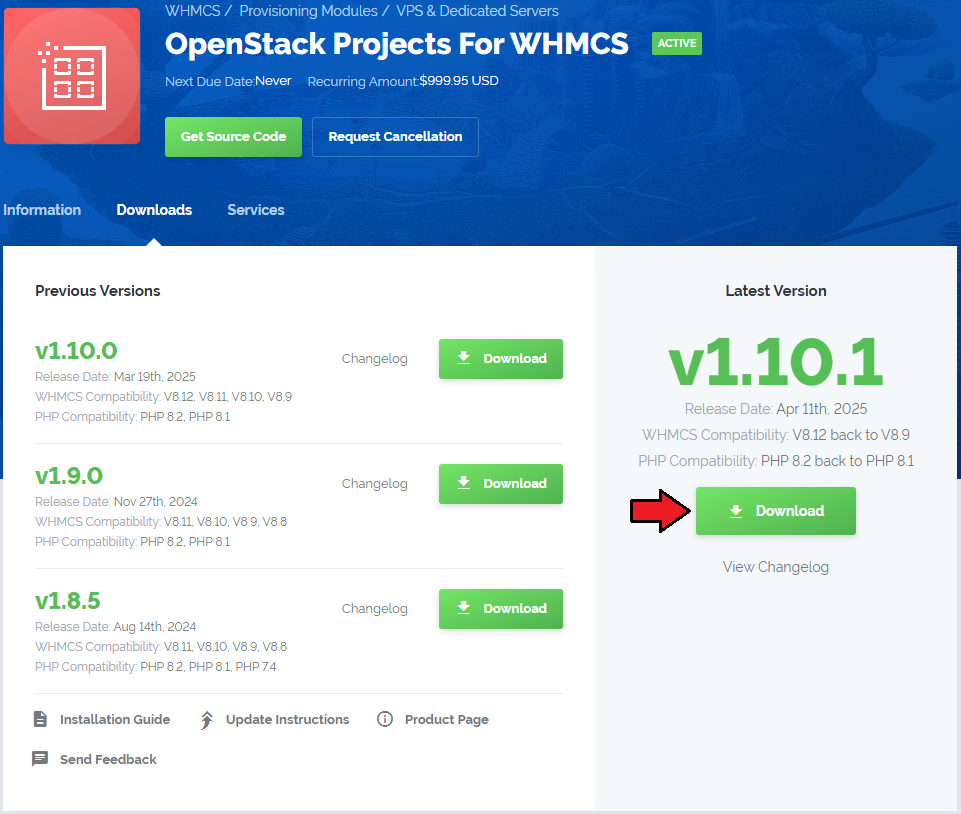
|
| 2. Upload and extract the extension into the main WHMCS directory. Extracted files in your WHMCS directory should look like this: |
| 3. When you install OpenStack Projects For WHMCS for the first time, you have to rename the 'license_RENAME.php' file. The file is located in '/yourWHMCS/modules/servers/OpenStackProjects/license_RENAME.php'. Rename it from 'license_RENAME.php' to 'license.php'. |
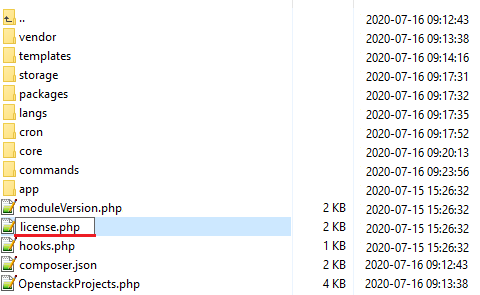
|
| 4. In order to configure your license key, you have to edit the previously renamed 'license.php' file. Enter your license key between the quotation marks as presented on the following screen. |

|
| 5. Now you have to activate the module in your WHMCS system. Log in to your WHMCS administrator area. Go to 'System Settings' → 'Addon Modules'. |
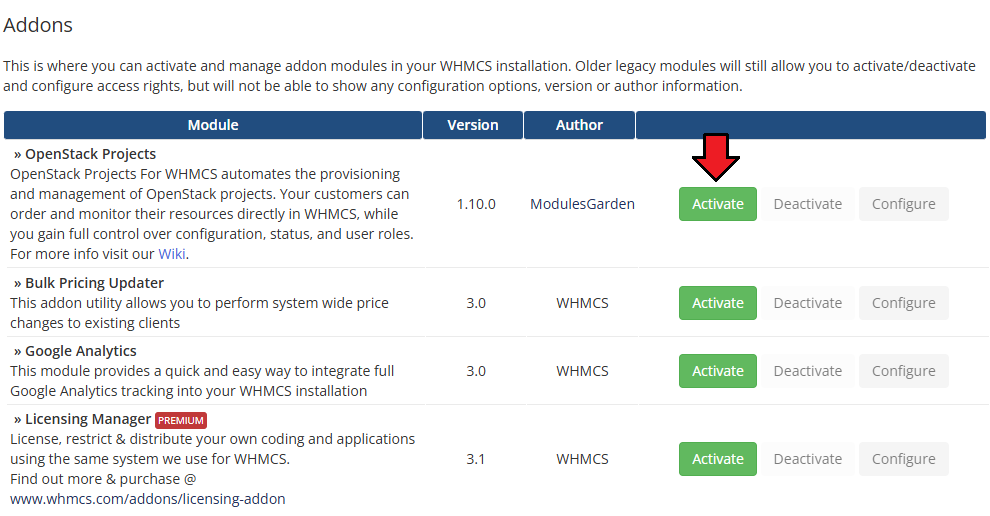
|
| 6. In the next step, you need to permit access to the module. To do so, click on the 'Configure' button, select administrator groups that should have access to this addon and press 'Save Changes'. |
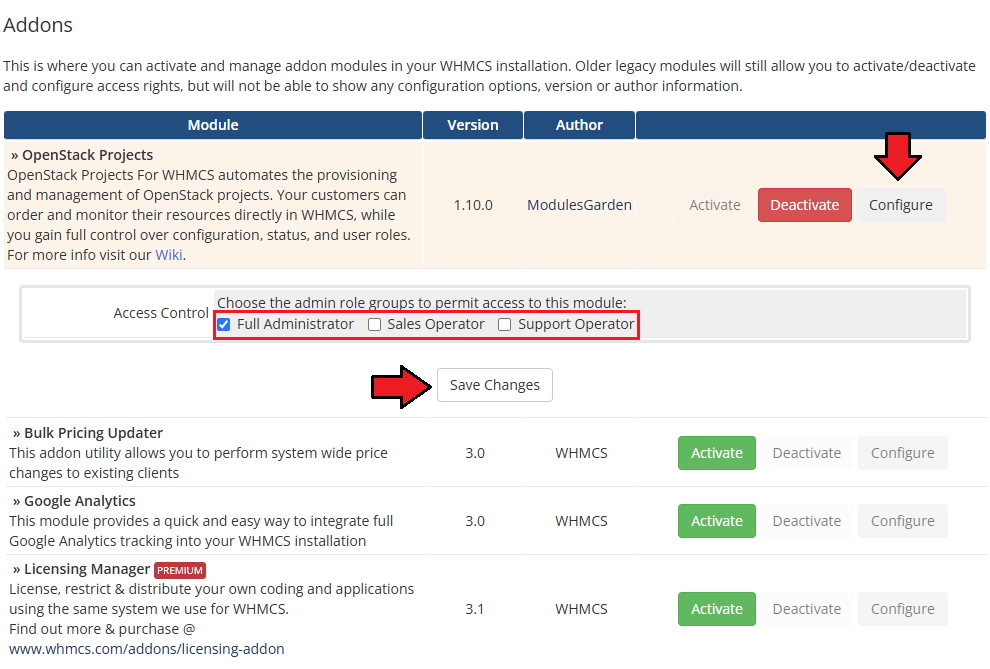
|
7. Finally, set up the cron command line provided below and define its frequency (1 minute interval is suggested).
php -q /yourWHMCS/modules/servers/OpenstackProjects/cron/cron.php queue This enables tasks such as 'suspend resources,' 'unsuspend resources,' 'terminate resources,' and 'lock account' to queue and run. |
| 8. You have just successfully installed OpenStack Projects For WHMCS! You can access your module under 'Addons' → 'OpenStack Projects'. |
[edit] Configuration of Server
| Before you can go on, you need to copy your 'API Details' . You will need them to connect with the server successfully. Proceed to your 'OpenStack' panel. All necessary information will be found in the 'View Credentials' section under 'API Access' . |
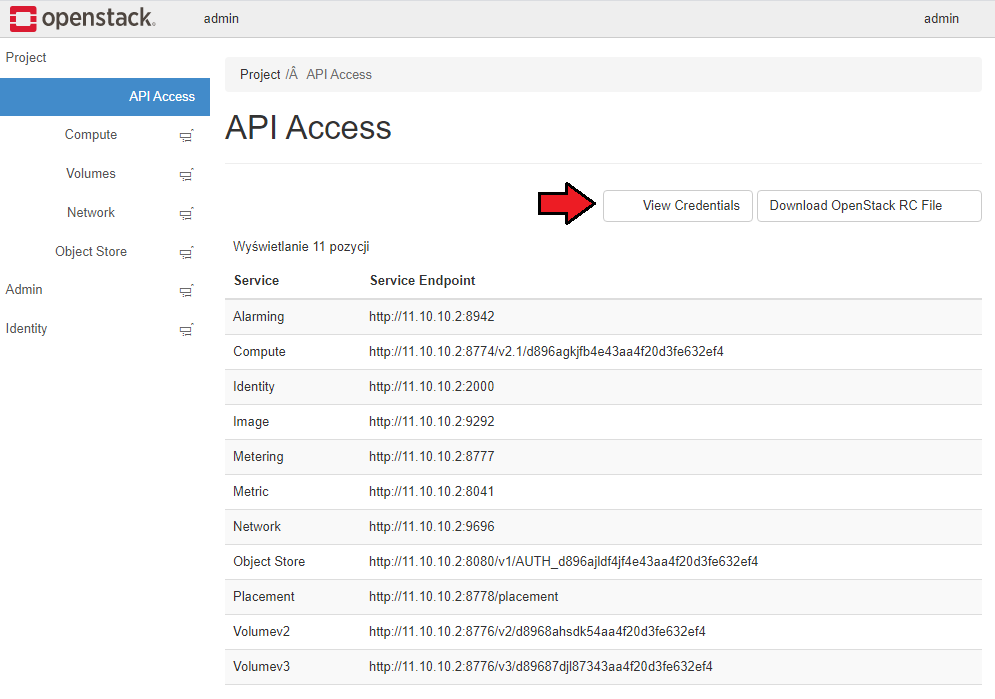
|
| 9. Now, log in to your WHMCS and proceed to 'System Settings' → 'Products/Services' → 'Servers' and press 'Add New Server'. |
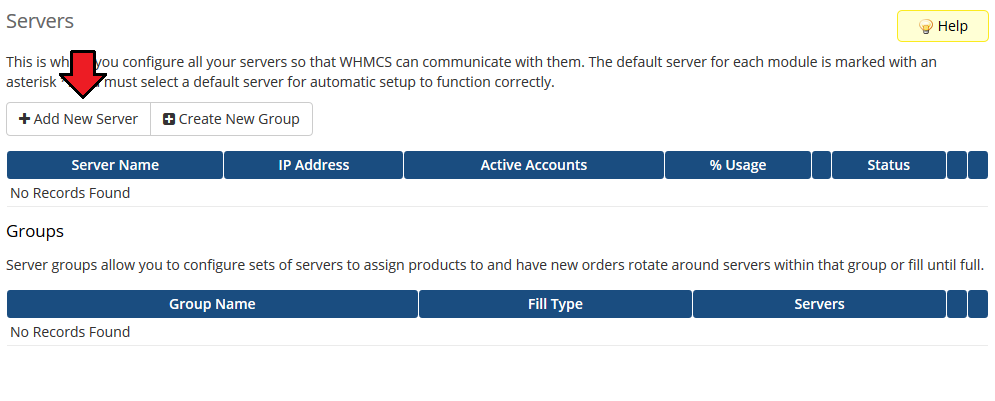
|
| 10. Next, enter your server 'Name' , 'Hostname' , 'IP Address' and select 'Openstack Projects' from the 'Module' field. Now, provide your 'OpenStack Server Details' . To download the 'Identity Version' , you need to click 'Get Versions' next to 'Identity Port/Path' . Important: The module supports OpenStack providers that allow access to the OpenStack API with system admin-level permissions. |
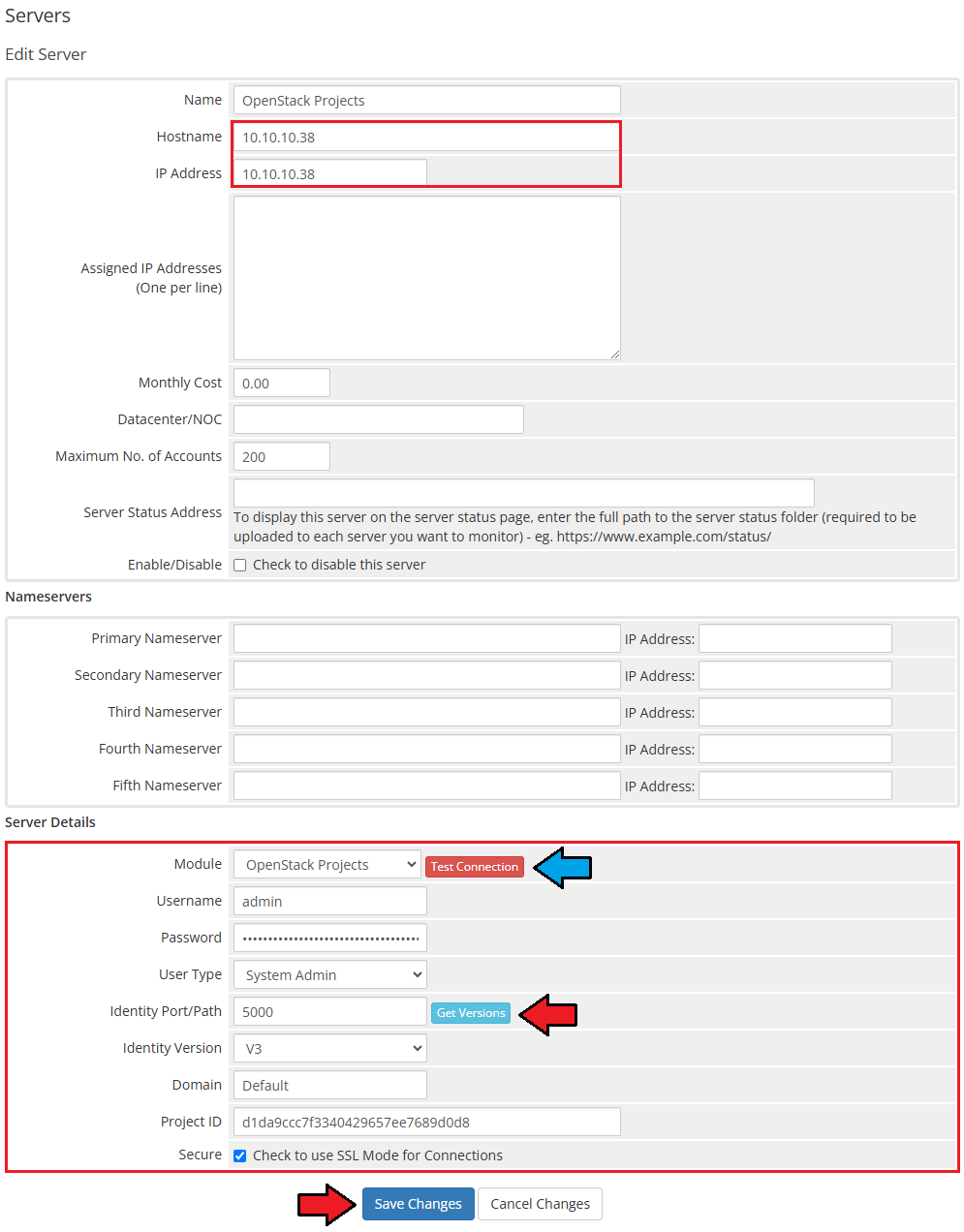
|
| Integration with Virtuozzo Hybrid Infrastructure If you you use Virtuozzo Hybrid Infrastructure (VHI) – OpenStack from Virtuozzo, please use the following guide: 1. WHMCS server must have access to VHI OpenStack API, please open the required ports according to the guide 2. Configure OpenStack endpoint OpenStack endpoint 3. Use system admin or domain admin credentials to access the cluster from WHMCS side:
Use the above data to fill out the server creation form in the WHMCS admin area. |
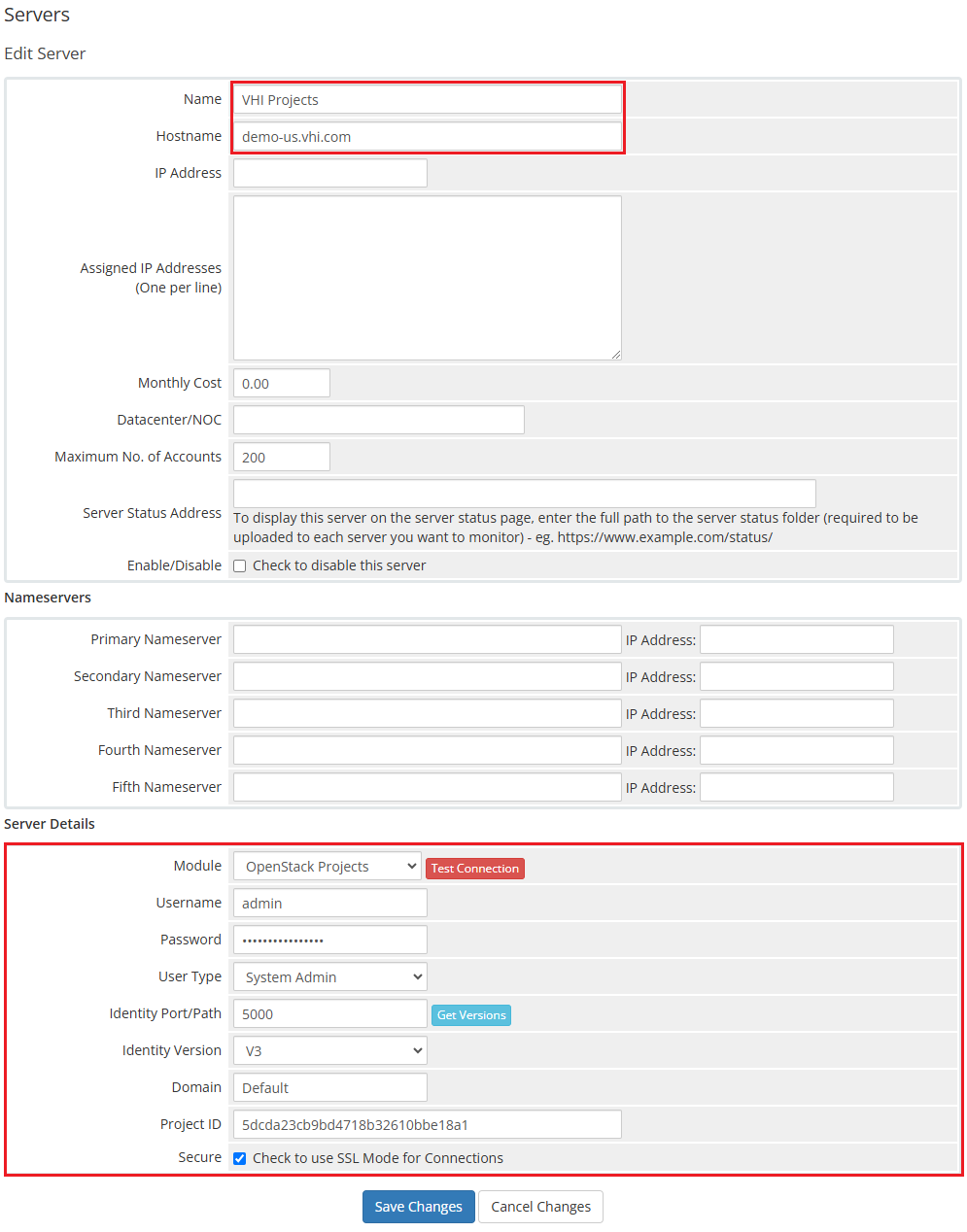
|
| 11. It is time to create a server group. To do so, click on 'Create New Group' . |
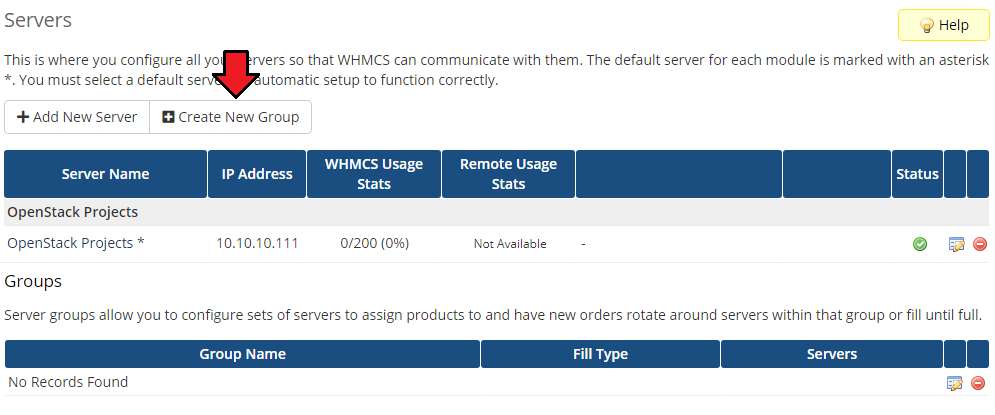
|
| 12. Enter a name, click on your previously created server, press 'Add' and afterward 'Save Changes' . Important: Please do not add more than one server into a single server group, as the module always fetches data from the first server listed in the group. |
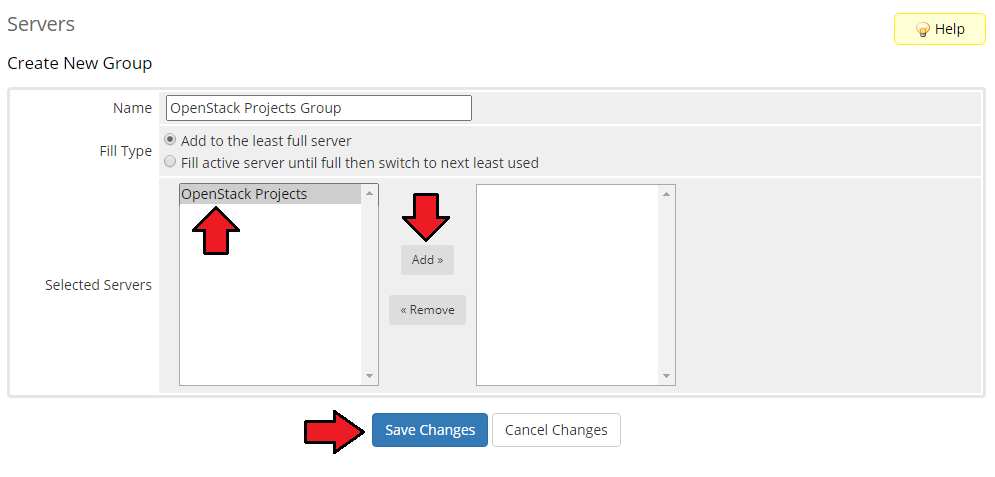
|
[edit] Configuration of Product
| 13. In order to create and configure a product, go to 'System Settings' → 'Products/Services' → 'Products/Services'. Click on 'Create a New Group'. |

|
| 14. Enter your product group name and press 'Save Changes'. |
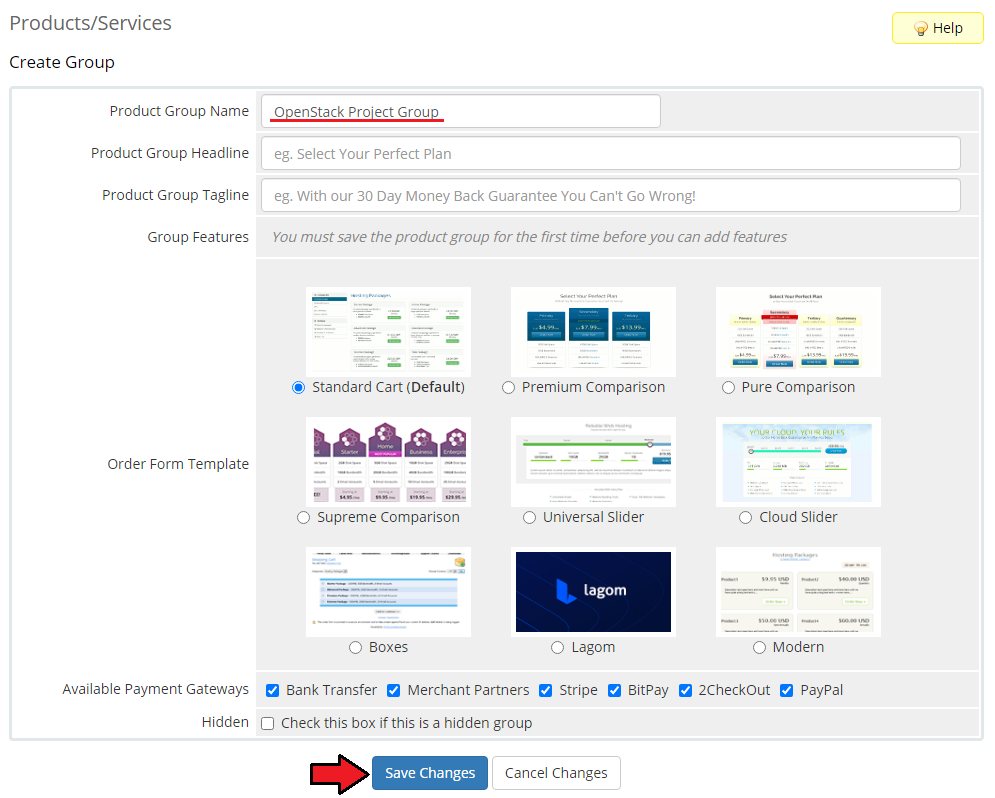
|
| 15. Once you have a product group, you can create a new product. To do so, click 'Create a New Product'. |

|
| 16. Afterward, choose your product type, enter your product name, choose module and the product group from the dropdown menus. Press 'Continue'. |
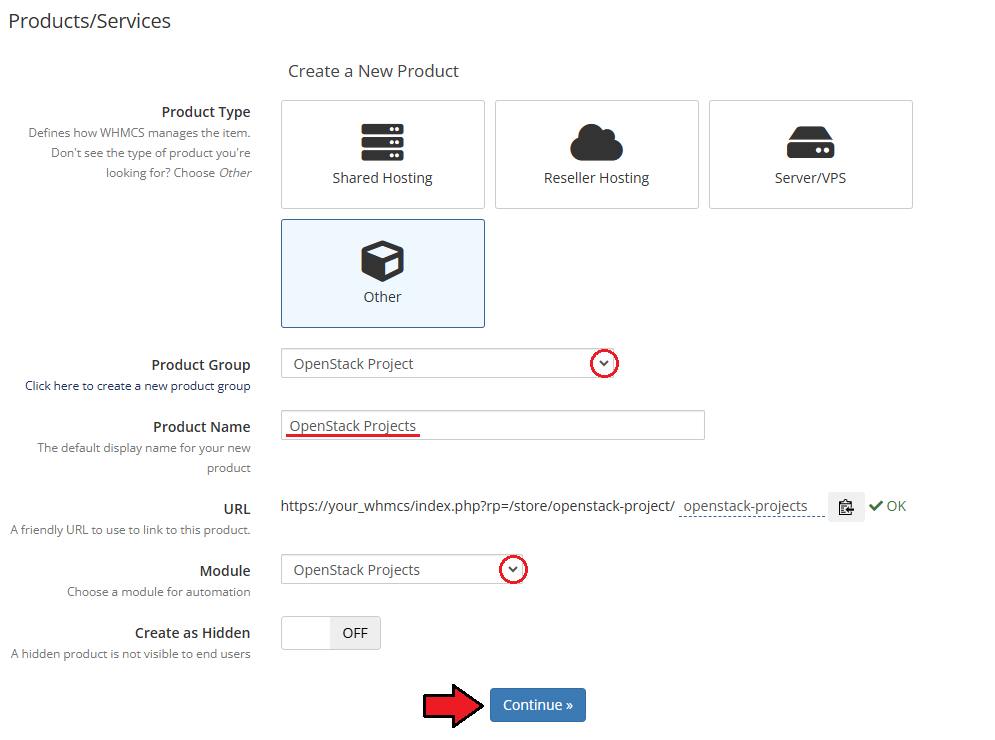
|
| 17. Now, go to the 'Module Settings' section, choose your previously created server group from the dropdown menu. |
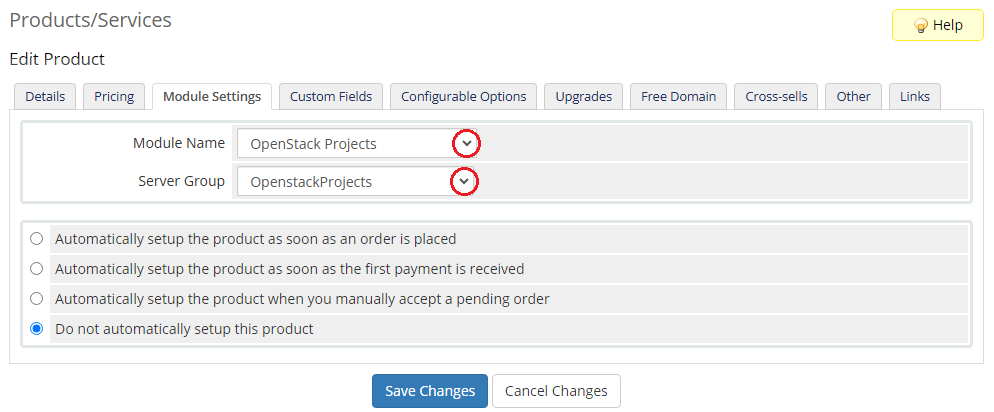
|
| 18. Now, let's start configuring the settings. Note: The below description refers to the "VHI" product configuration. Configuration:
|
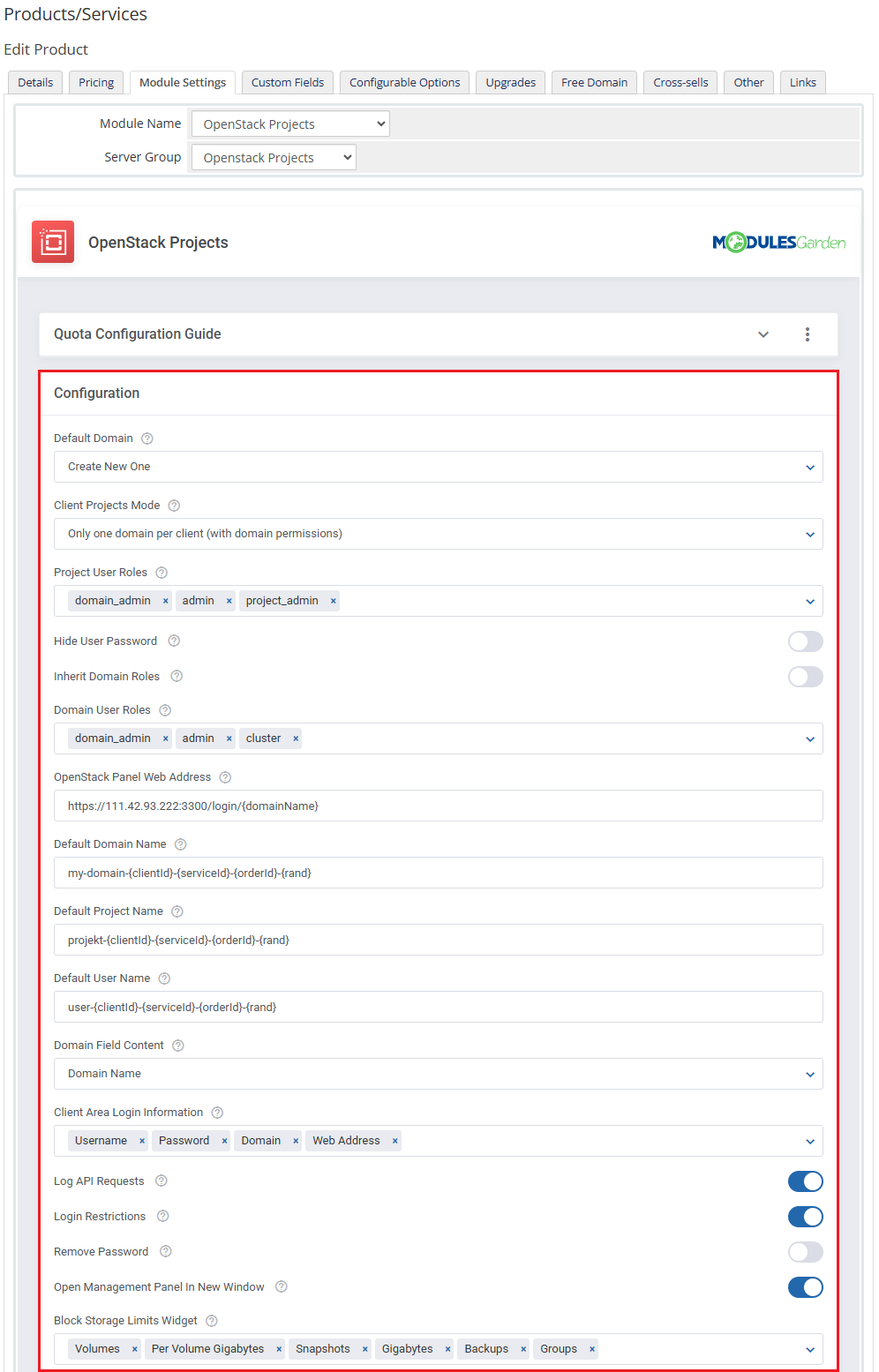
|
|
Compute, Block Storage, Network, Load Balancer, Container Infrastructure, Traits - |
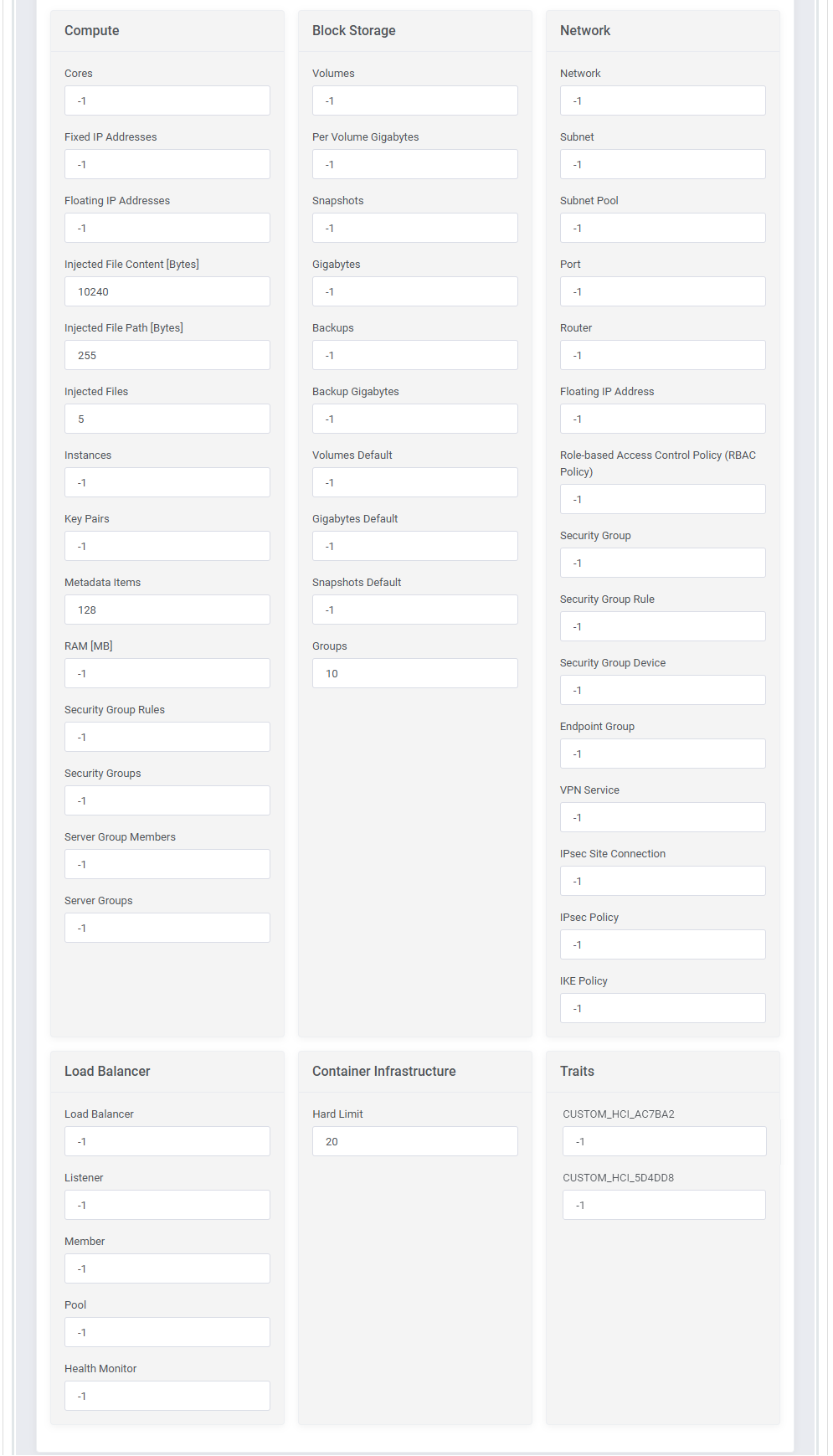
|
| In the QoS Rules configuration, certain QoS rules are consolidated into a single rule and respectively into a single configurable option. |
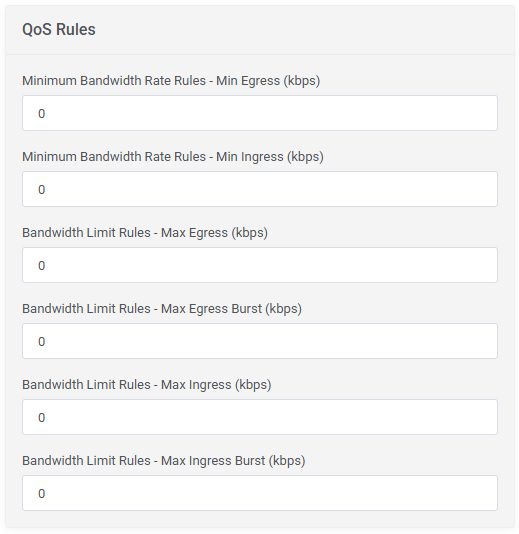
|
[edit] Module Hooks
|
Module Custom Web Hooks - here you may add the URL with WHMCS parameters to perform additional actions after the create/suspend/unsuspend/terminate/change package actions. |
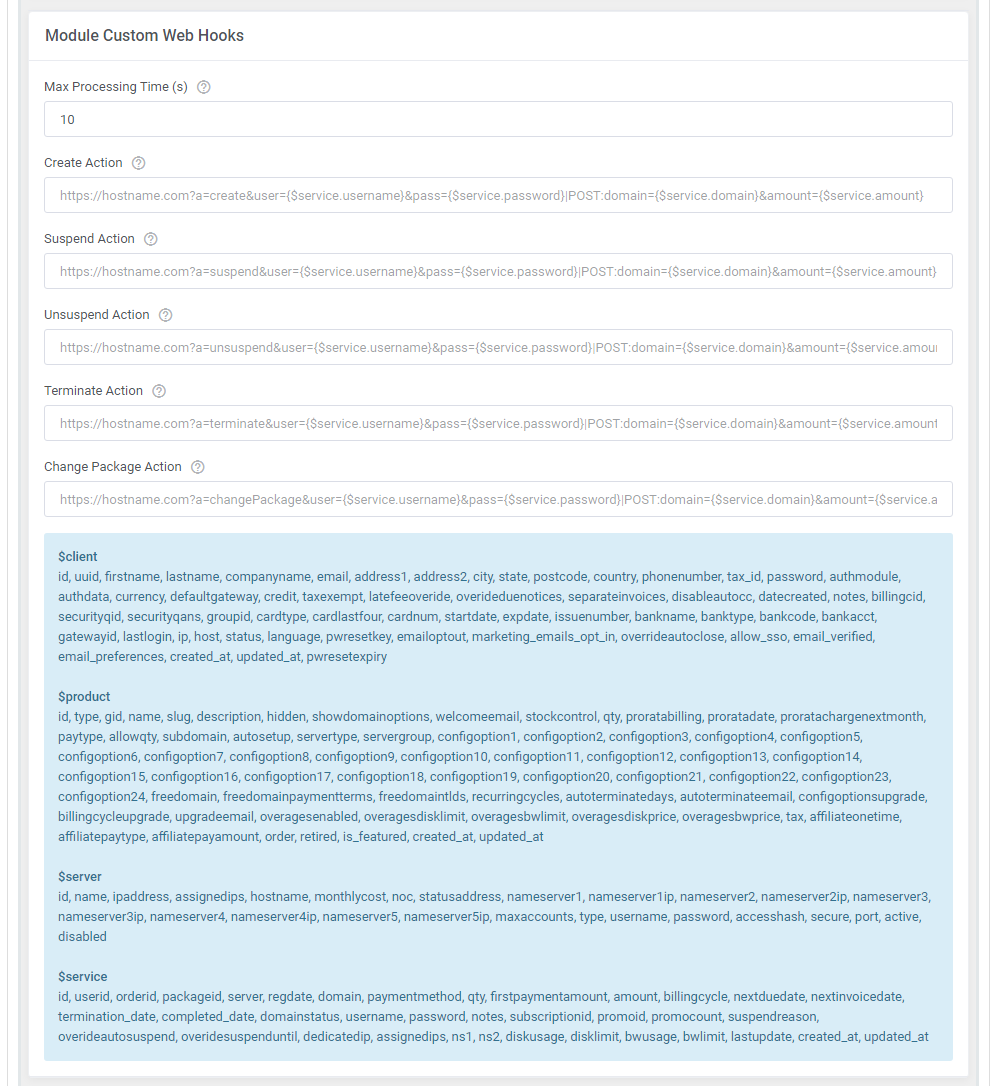
|
|
Module Custom Shell Hooks - enter the commands with WHMCS parameters to perform additional actions after the create/suspend/unsuspend/terminate/change package actions. |
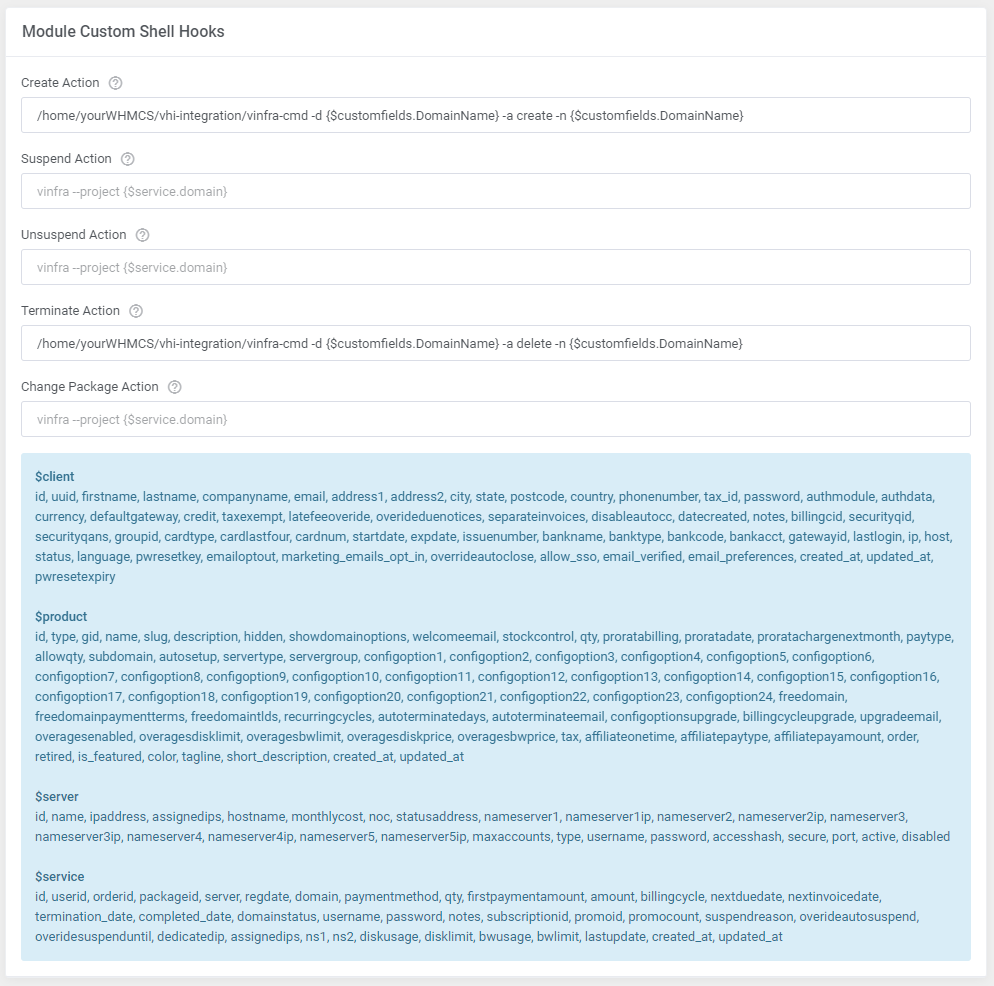
|
| 19. Optionally, you may configure the "Usage Billing Settings" that will be utilized for the Advanced Billing For WHMCS integration. Select specific networks and IP address versions for custom parameter calculations. Important: Virtual Machines are billed only when they are directly connected to a custom network marked for billing by the administrator '(Custom Network Metric Statistics)'. Note: Advanced Billing For WHMCS version 4.x is required, previous versions are not supported. |

|
[edit] Configurable Options
| 20. At the end of the configuration process, you can enable 'Metric Billing' and decide whether you want to generate configurable options for the product. Configurable options can be used by your clients to select each virtual machine parameter individually during order placement. There is also an 'Alternative Mode' available, which changes the way the configurable options values are verified and calculated. |

|
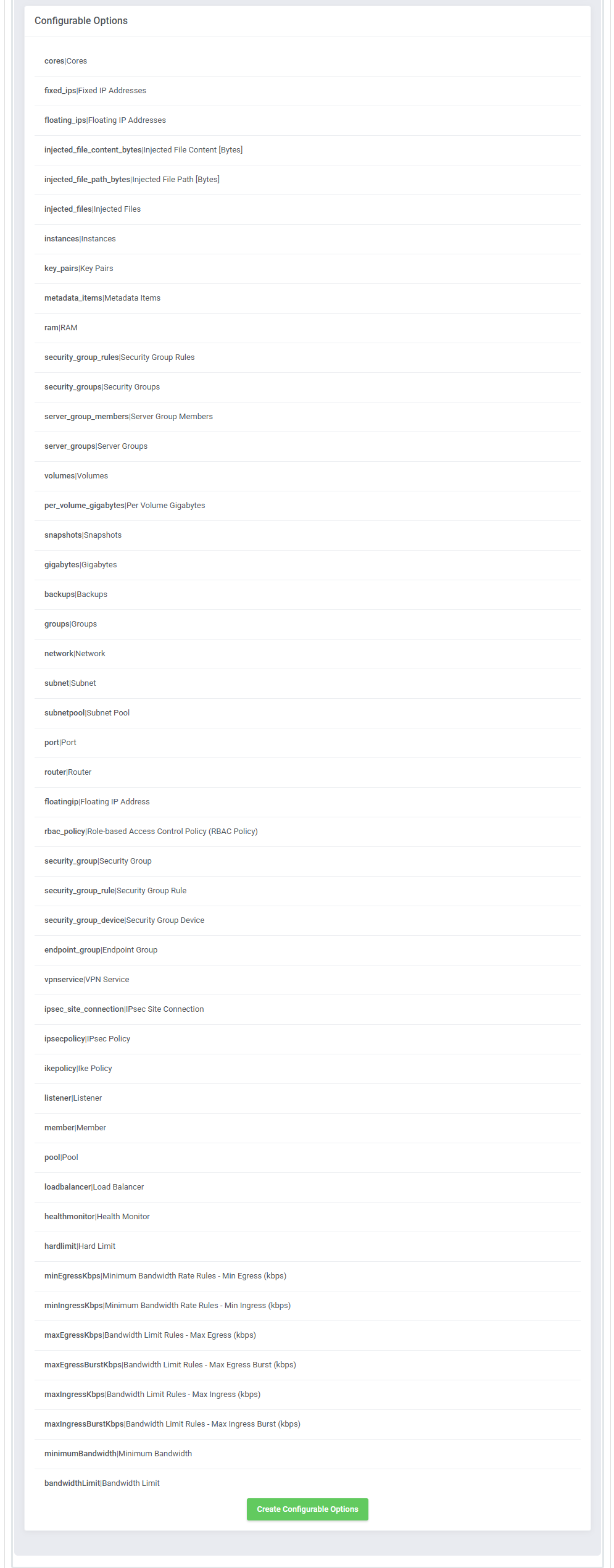
|
| Now, select which options you want to generate and confirm by clicking 'Create' . Note that the configuration for disabled options will still be taken from the configuration of the main product. More information about how to use configurable options can be found here or in the official WHMCS documentation. |
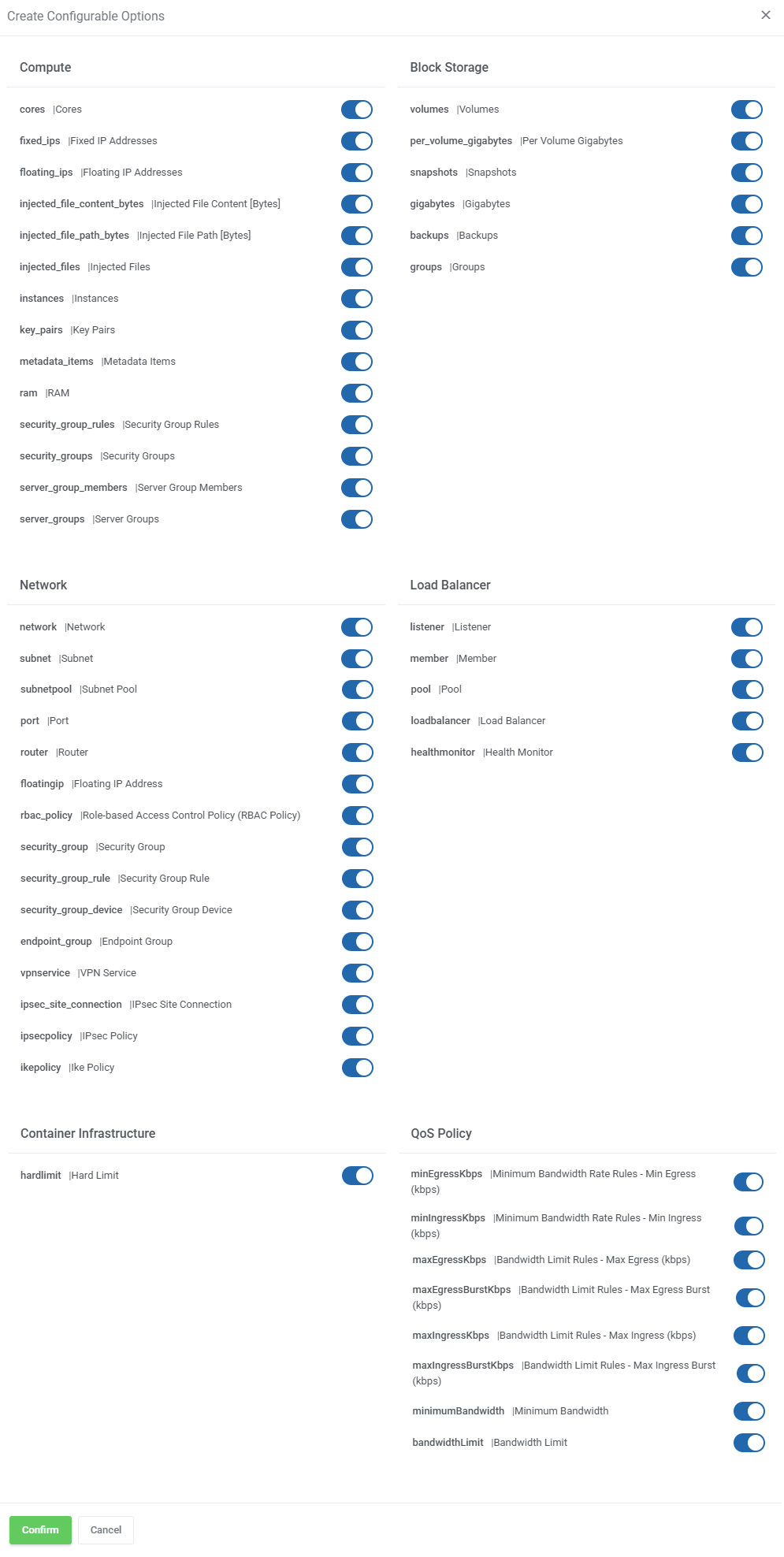
|
| There are specific exceptions where options must be configured together to create a functional rule. The following rules must be set together, as the API requires several parameters to be specified, therefore they are now combined into one configurable option for your comfort of use. These are:
Configured as:
Configured as:
Configured as:
Configured as: |
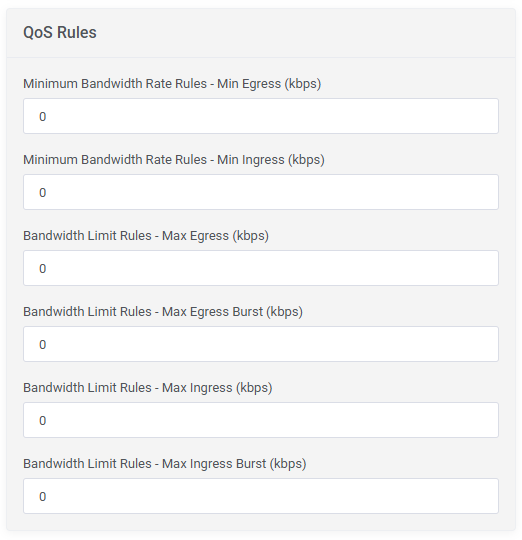
|
| For example:
In the QoS Policy generate the following configurable options:
This will result in the following configuration (overwriting the product configuration QoS Rules): |

|
[edit] User Roles Configuration
Roles, or in other words permissions, in OpenStack can be assigned to users, they can be associated with either a domain or a project.
|
| Move to 'Products/Services' → 'Module Settings' → 'Configuration'. There you will find all the options associated with the roles configuration: |
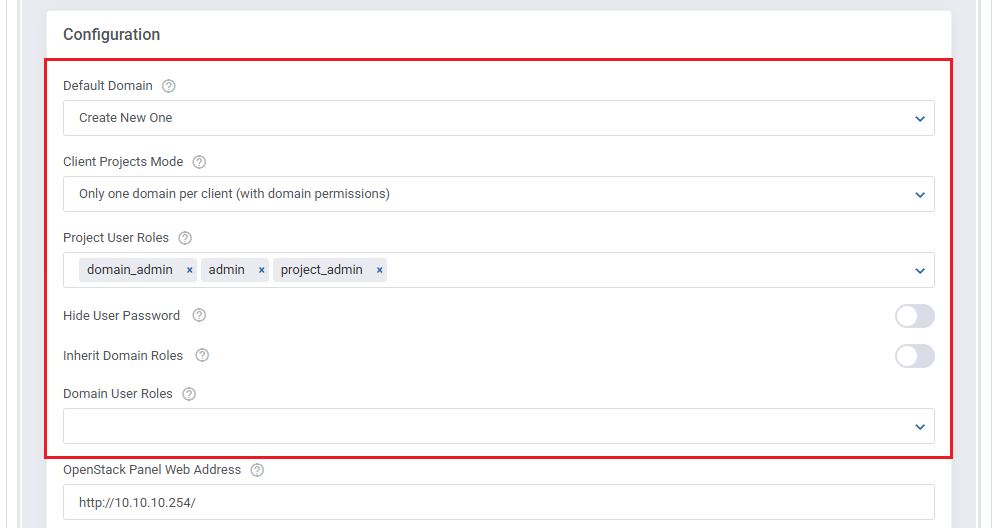
|
|
| Important: When upgrading from 1.3.0 to 1.4.0 module version and you do not save changes in the module settings the roles will work as in the previous version. |
[edit] Quota Configuraton Guide
[edit] Adding Quotas Using CLI
| Before configuring quotas, it's essential to identify which quotas your OpenStack environment supports. To set quotas via the module, they must be added to the Use the following CLI commands to list available quotas from your OpenStack environment: openstack quota show --compute -f json openstack quota show --network -f json openstack quota show --volume -f json openstack loadbalancer quota show default -f json openstack coe quota list openstack trait list |
| Next, edit the 'quotas.json', ensure that the quotas specified align with the capabilities and limitations of your OpenStack setup. Important: |
Example Configuration For Compute, Network, and Volume Quotas
[
{
"Resource": "cores",
"Limit": -1
},
{
"Resource": "instances",
"Limit": -1
},
{
"Resource": "ram",
"Limit": -1
},
{
"Resource": "fixed_ips",
"Limit": null
},
{
"Resource": "floating_ips",
"Limit": null
},
{
"Resource": "networks",
"Limit": null
},
{
"Resource": "security_group_rules",
"Limit": null
},
{
"Resource": "security_groups",
"Limit": null
},
{
"Resource": "injected-file-size",
"Limit": 10240
},
{
"Resource": "injected-path-size",
"Limit": 255
},
{
"Resource": "injected-files",
"Limit": 5
},
{
"Resource": "key-pairs",
"Limit": -1
},
{
"Resource": "properties",
"Limit": 128
},
{
"Resource": "server-group-members",
"Limit": -1
},
{
"Resource": "server-groups",
"Limit": -1
}
]
"compute": {
"quota_resource_name": "default_limit_value"
}
"compute": {
"cores": -1,
"instances": -1,
"ram": -1,
"fixed_ips": null,
"floating_ips": null,
"networks": null,
"security_group_rules": null,
"security_groups": null,
"injected-file-size": 10240,
"injected-path-size": 255,
"injected-files": 5,
"key-pairs": -1,
"properties": 128,
"server-group-members": -1,
"server-groups": -1
}
|
Example Configuration For Load Balancer Quota
{
"load_balancer": 0,
"listener": -1,
"pool": -1,
"health_monitor": -1,
"member": -1,
"l7policy": -1,
"l7rule": -1
}
"loadBalancer": {
"load_balancer": 0,
"listener": -1,
"pool": -1,
"health_monitor": -1,
"member": -1,
"l7policy": -1,
"l7rule": -1
}
|
Example Configuration For Container Infrastructure Quota
|
| project_id | resource | hard_limit |
|---|---|---|
| 5dcda23cb9bd4718b32610bbe18a1382 | Cluster | 20 |
"containerInfra": {
"hard_limit": 20
}
|
Example Configuration For Placement / Traits
|
| name |
|---|
| COMPUTE_NET_VIF_MODEL_SRIOV |
| HW_CPU_AARCH64_FCMA |
| HW_CPU_X86_AMD_SSBD |
| HW_NIC_OFFLOAD_GSO |
| CUSTOM_MG |
| CUSTOM_HCI_5EDCF1C91EEC41839078D7C9FF3F6A46 |
| CUSTOM_HCI_9F5665A0B47C40438E20F0B866B79703 |
| CUSTOM_HCI_D3E179EFBF1F42FF854C791410C82B66 |
"traits": {
"CUSTOM_MG": 1
}
|
[edit] Block Storage Quota Configuration
To configure available quotas, update the following file:
modules/servers/OpenstackProjects/app/Config/quotas.json Manually add additional storage types to block storage as needed. To set a volume size limit for block storage, modify the Example Configuration for SSD Volume Type To specify an unlimited quota for SSD volumes, use the following setting: "gigabytes_ssd": -1
"blockStorage": {
....
"gigabytes_default": -1,
"gigabytes_ssd": -1
}
Once the file is updated and the page is refreshed, the new quota will be reflected in the Block Storage section. |
[edit] Default Quota Configuration
Below is an example of the default quotas.json configuration. By ensuring these settings are correctly configured, your OpenStack Projects For WHMCS module will properly enforce quotas across your environment. {
"compute": {
"cores": -1,
"fixed_ips": -1,
"floating_ips": -1,
"injected_file_content_bytes": 10240,
"injected_file_path_bytes": 255,
"injected_files": 5,
"instances": -1,
"key_pairs": -1,
"metadata_items": 128,
"ram": -1,
"security_group_rules": -1,
"security_groups": -1,
"server_group_members": -1,
"server_groups": 30
},
"blockStorage": {
"volumes": 100,
"per_volume_gigabytes": 50,
"snapshots": 100,
"gigabytes": 300,
"backups": 10,
"backup_gigabytes": 200,
"volumes_default": -1,
"gigabytes_default": -1,
"snapshots_default": -1,
"groups": 10
},
"network": {
"network": -1,
"subnet": -1,
"subnetpool": -1,
"port": -1,
"router": -1,
"floatingip": -1,
"rbac_policy": -1,
"security_group": -1,
"security_group_rule": -1,
"security_group_device": -1,
"endpoint_group": -1,
"vpnservice": -1,
"ipsec_site_connection": -1,
"ipsecpolicy": -1,
"ikepolicy": -1
},
"loadBalancer": {
"load_balancer": -1,
"listener": -1,
"member": -1,
"pool": -1,
"health_monitor": -1
},
"containerInfra": {
"hard_limit": 20
},
"traits": {}
}
|
[edit] Management
| OpenStack Projects For WHMCS is a module that will allow you to provision virtual projects to your customers in a fully automatic manner. Check the manual below to learn how to configure the module to take all the advantages it has to offer. |
[edit] Addon Module
| While management of specific projects mostly takes place in the admin area, functions that affect the whole module can be found in the addon. See the section below for an in depth explanation of each of them. |
[edit] Queue
| At the top of this section you will find information regarding the cron job. The task cards can be used to filter the task table underneath. |
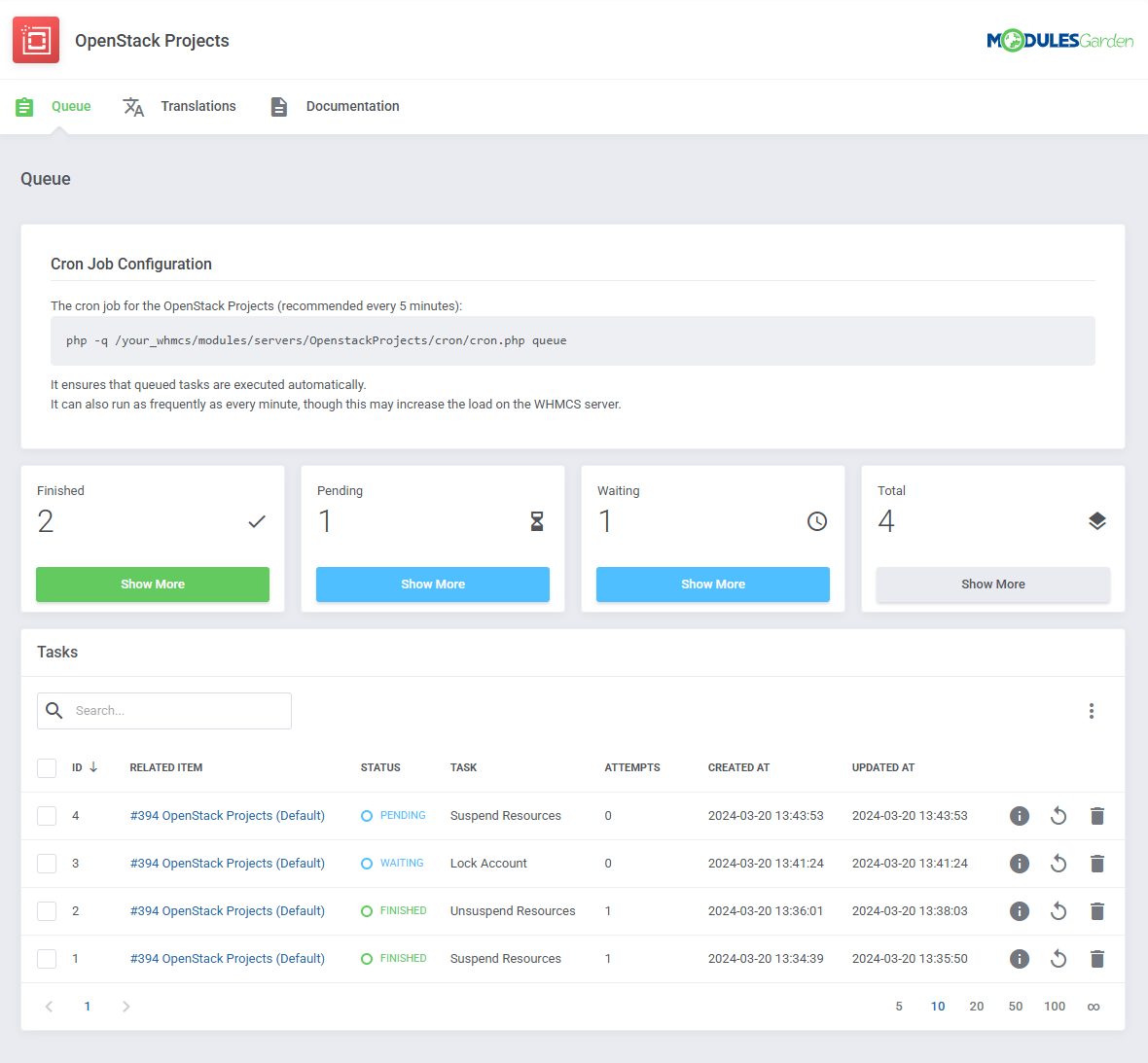
|
| Cron job tasks sent to the server through the module can be viewed and managed here. The basic information includes:
|
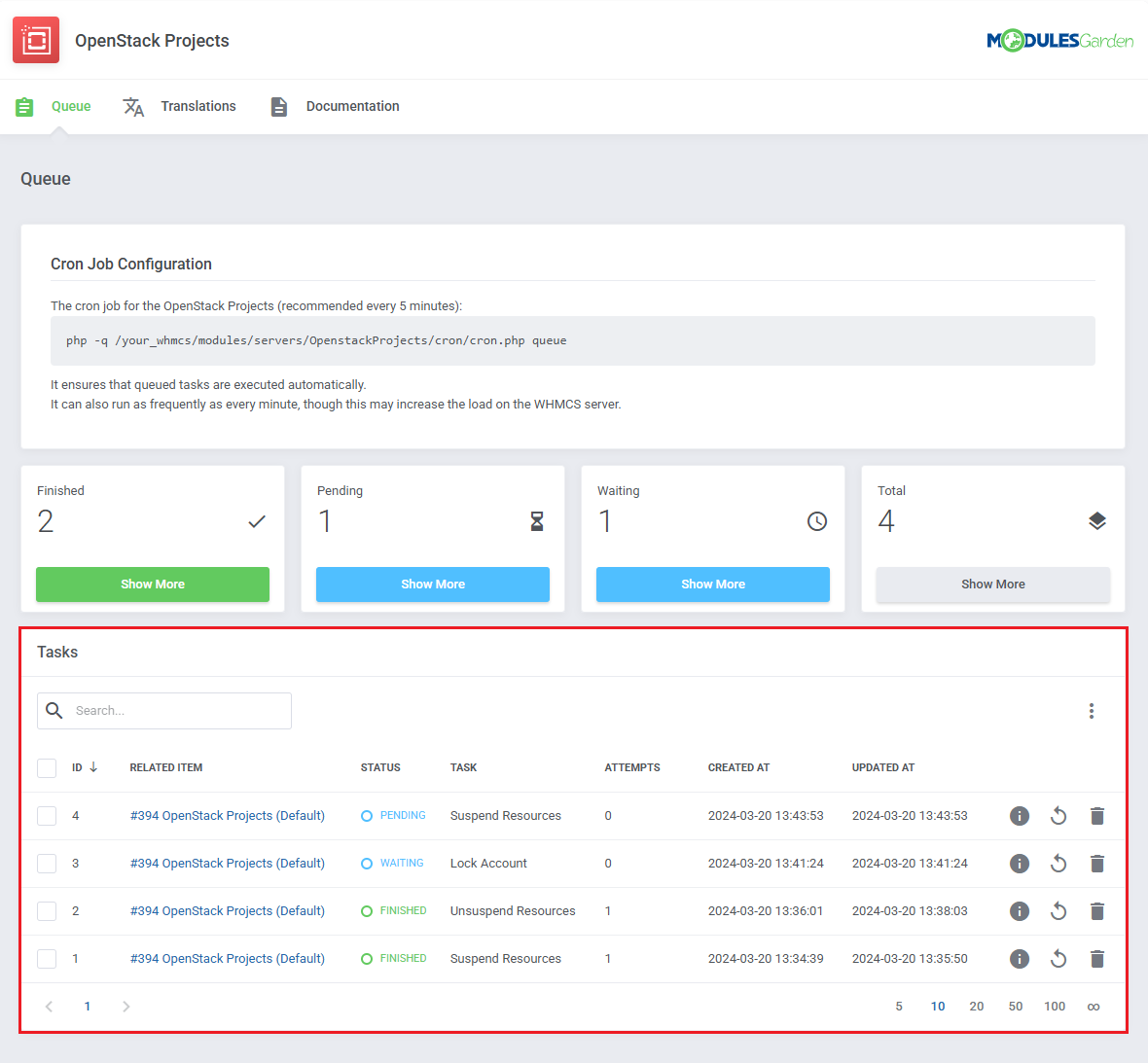
|
On the right side of the tasks list you will find the action buttons. These are in order:
|
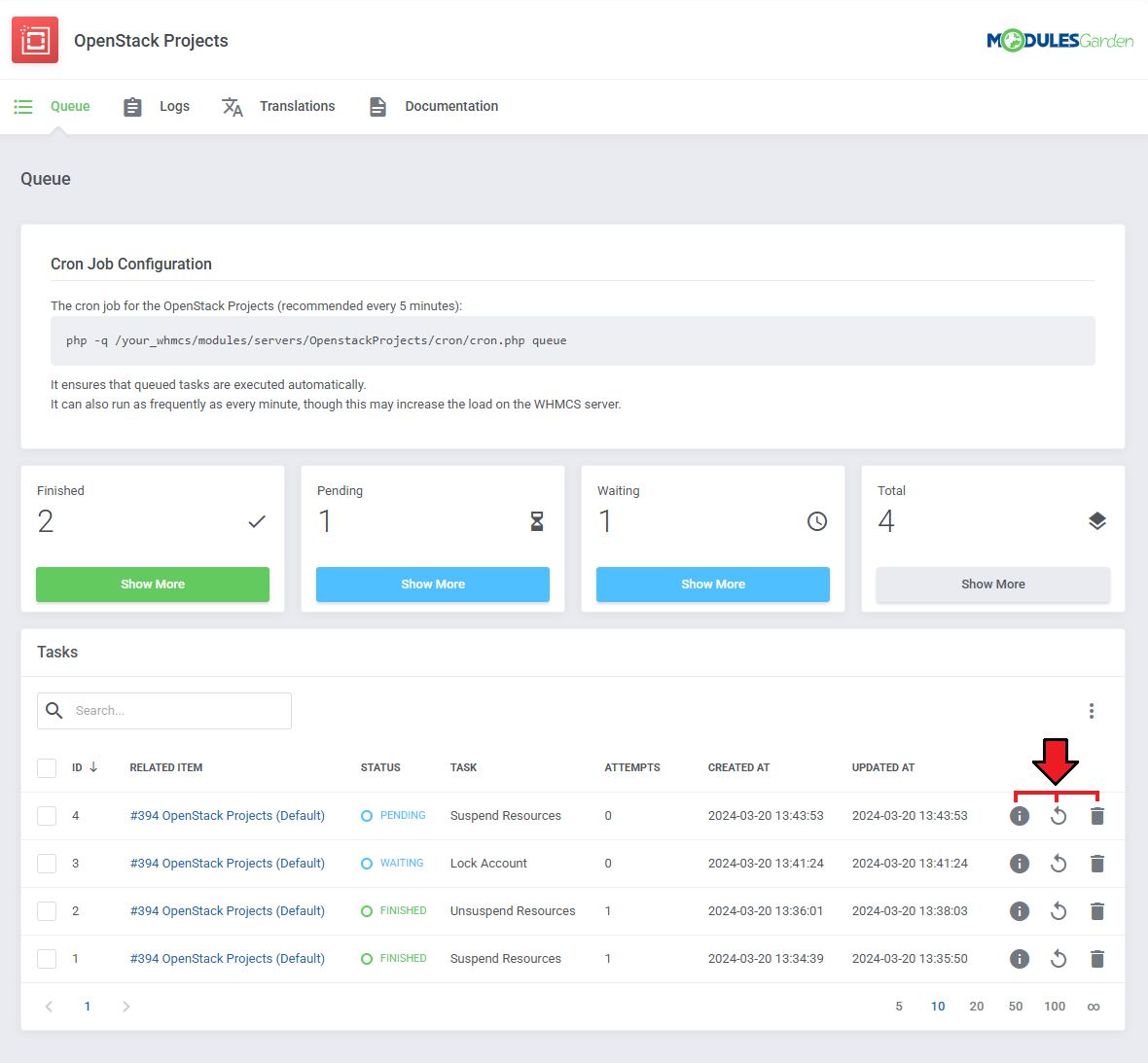
|
Moreover, you can change additional settings by clicking on the three dots above the basic actions.
|
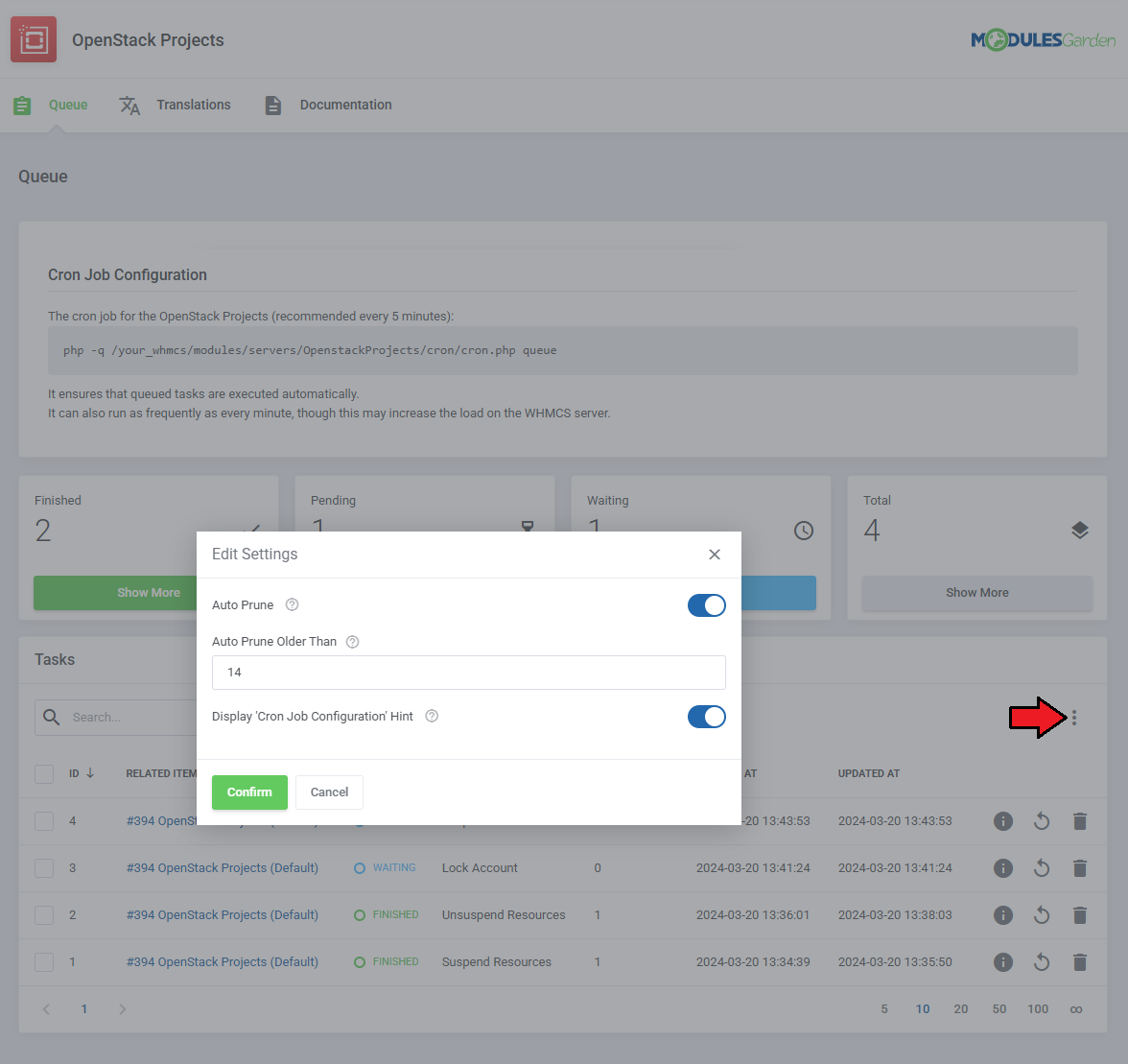
|
| Remember to make use of the search bar when you need to find a specific task, and the mass action feature, when you need to delete multiple tasks at once. |
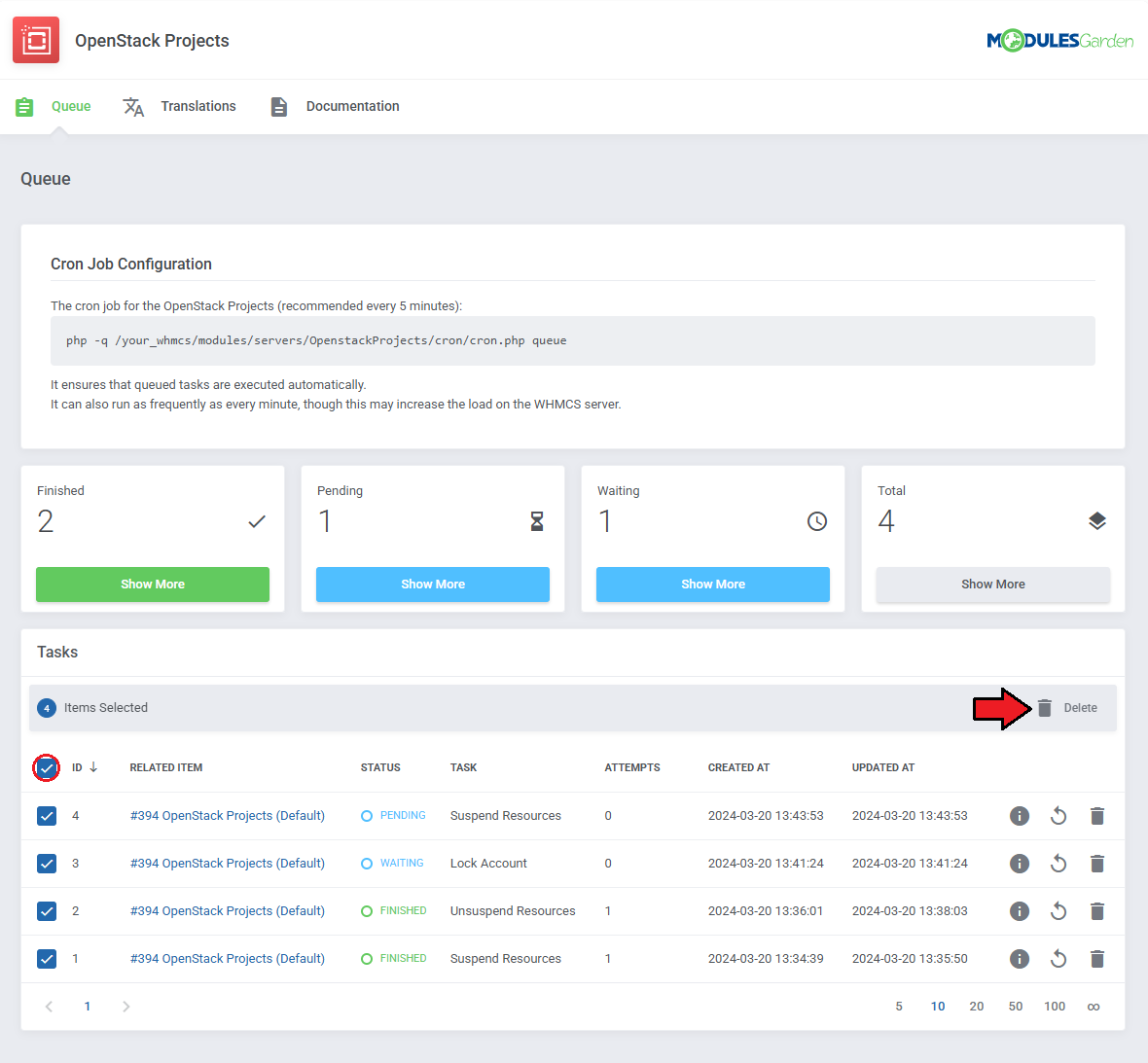
|
[edit] Translations
| Customizing language files is now extremely easy with the "Translations" tool that is now available directly in the addon. Its user-friendly design makes managing various language file tweaks a smooth and efficient process. Prepare translations for the original English files with this handy built-in tool. For specific instructions on how to use this tool please refer to its dedicated article, you will find it here. |
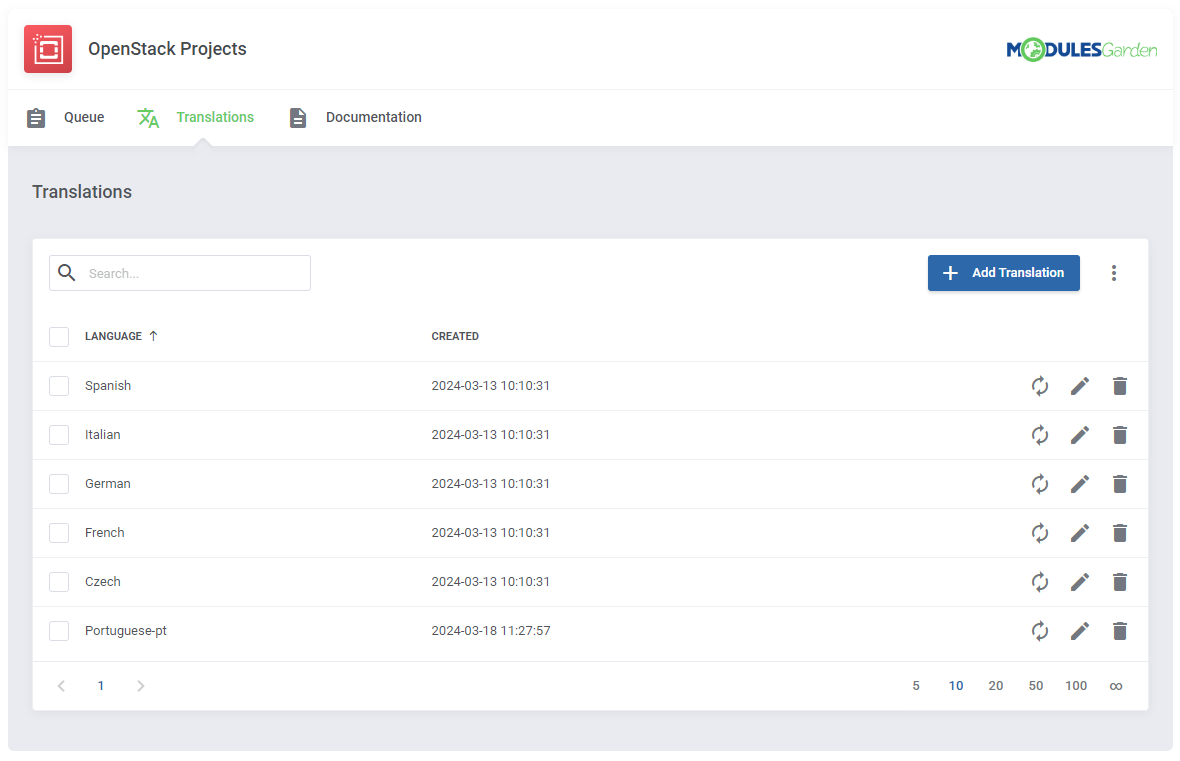
|
[edit] Admin Area
| OpenStack Projects For WHMCS allows you to supervise and manage your customer products from the admin area of your WHMCS system. This includes supervision of such features as:
|
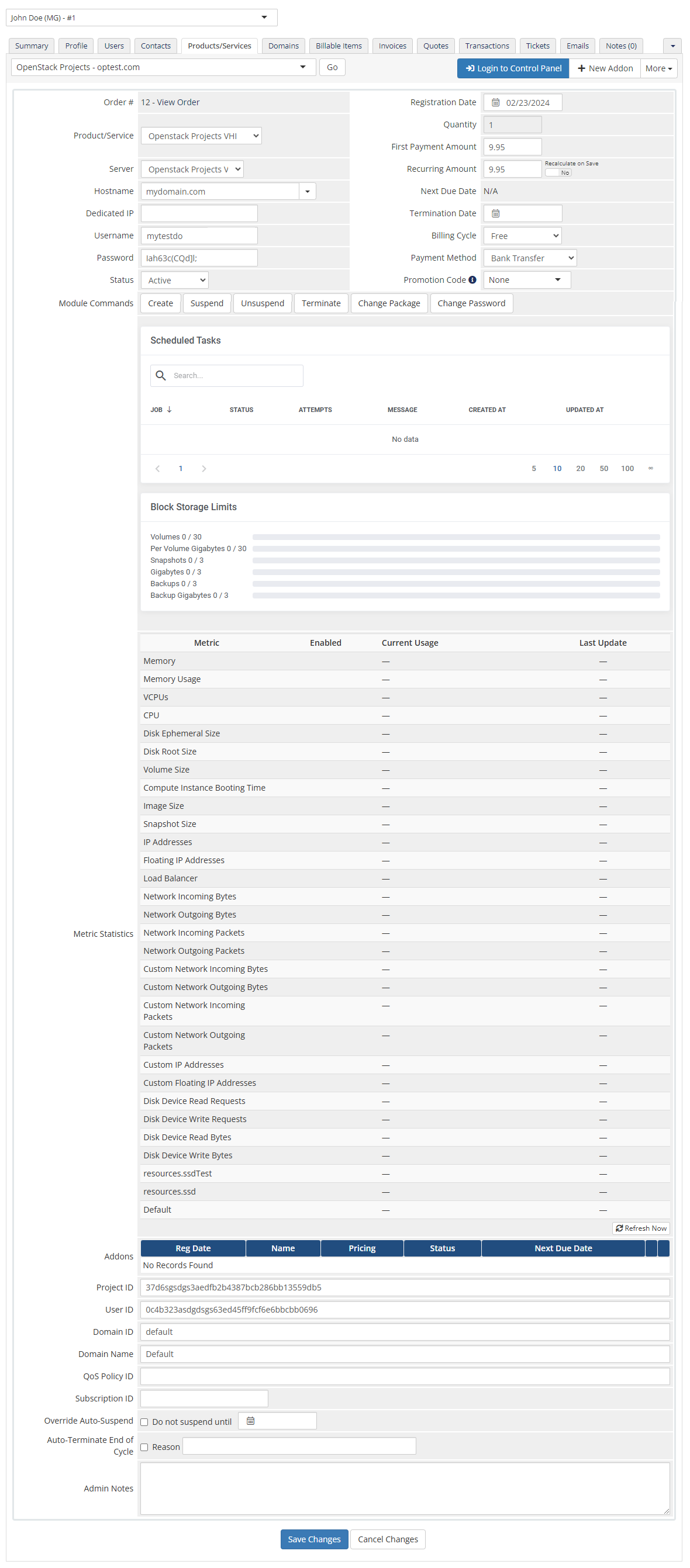
|
[edit] Ordering New Projects
| Thanks to configurable options, you are able to offer a product that your clients can match to their needs. Additionally, you are able to set up pricing for each configurable option, which makes your offer even more competitive. |
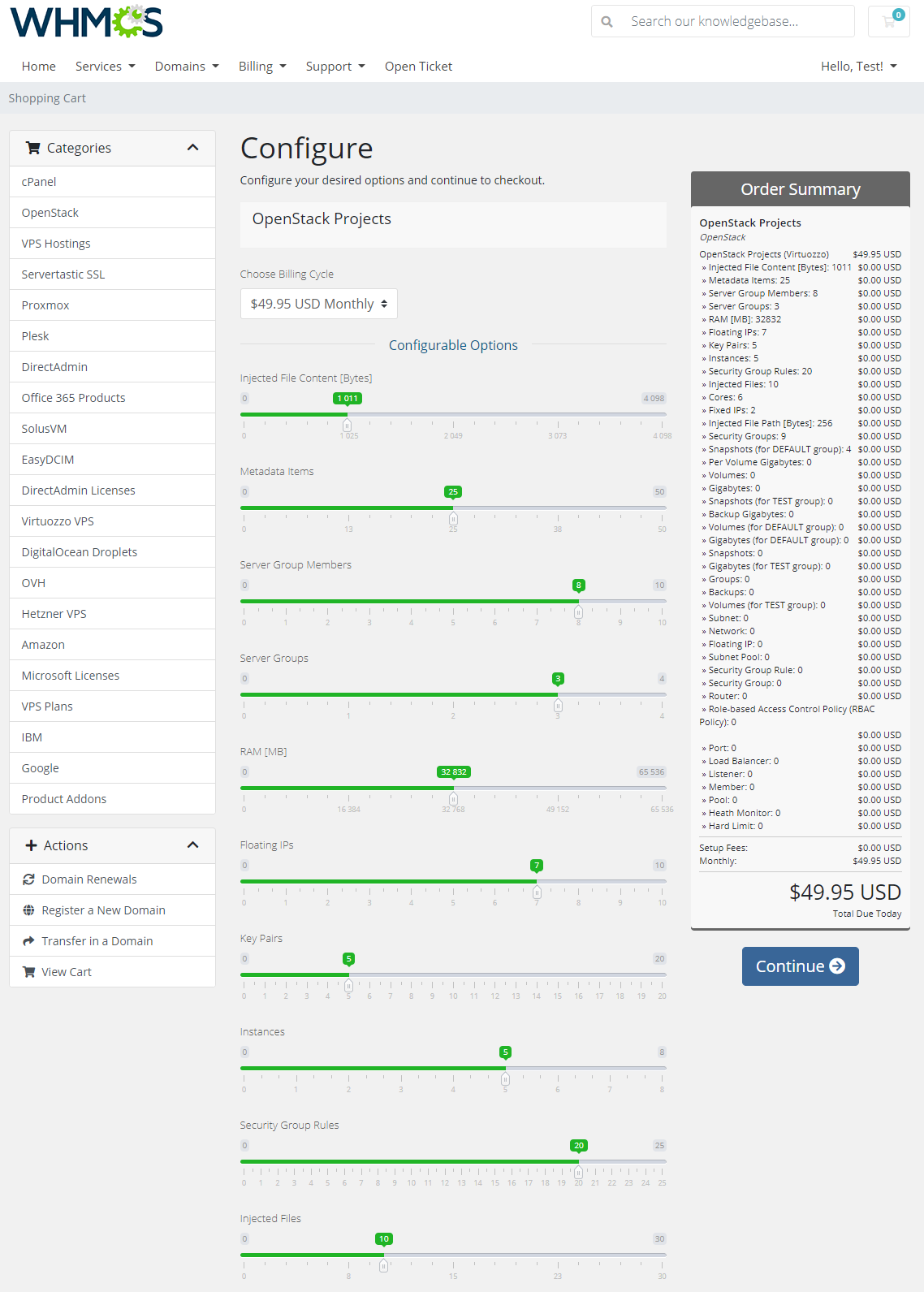
|
[edit] Importing Existing Project
| You can easily import existing projects into the module by following the instructions provided below: 1. Find a client to whom you want to assign a project. |
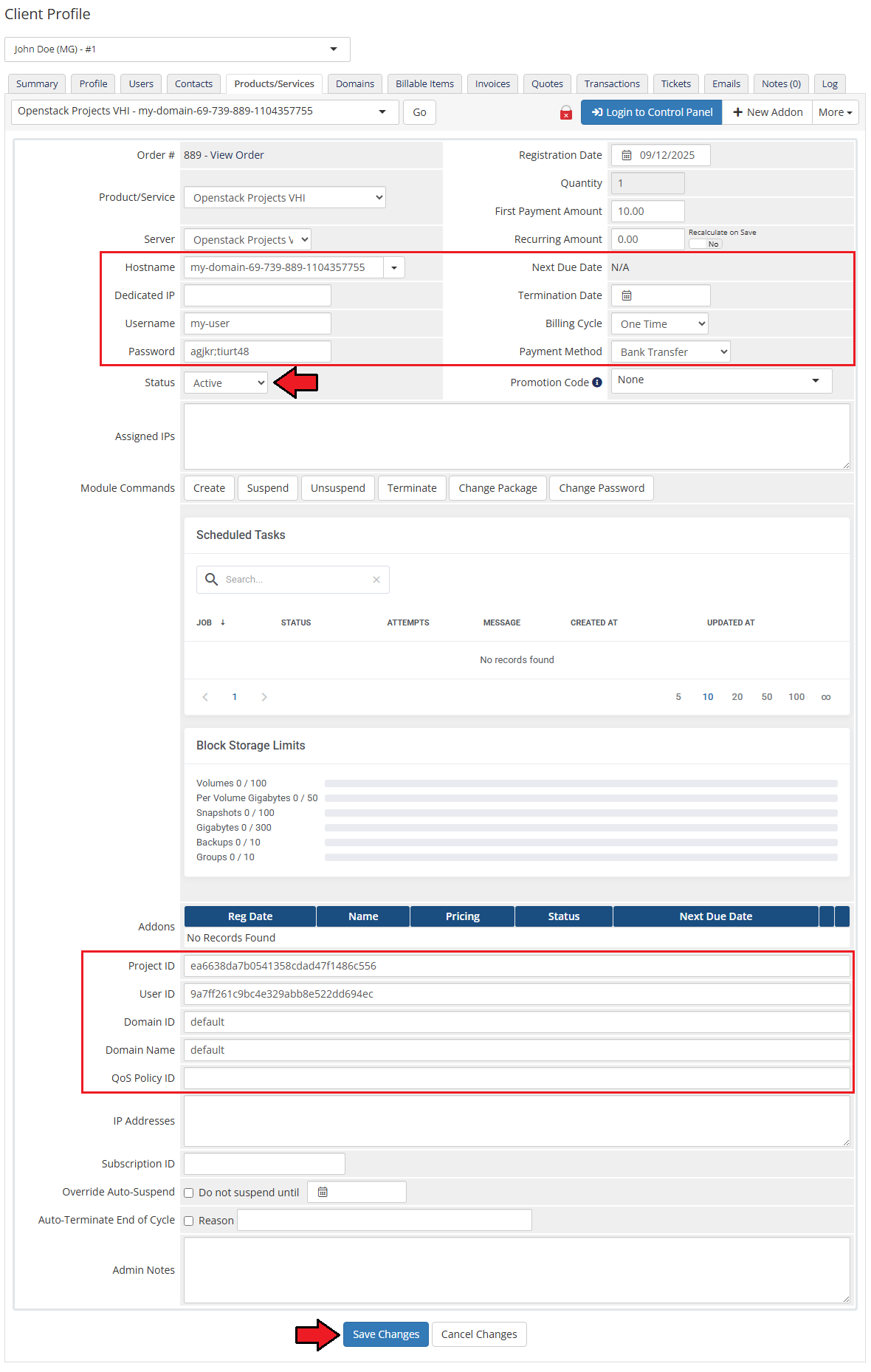
|
[edit] Client Area
| The client area interface of OpenStack Projects For WHMCS looks like this. As you can see, you may easily be redirected to the 'OpenStack' login page. Moreover, you can check the 'Configurable Options ' and 'Metrics Billing'. |
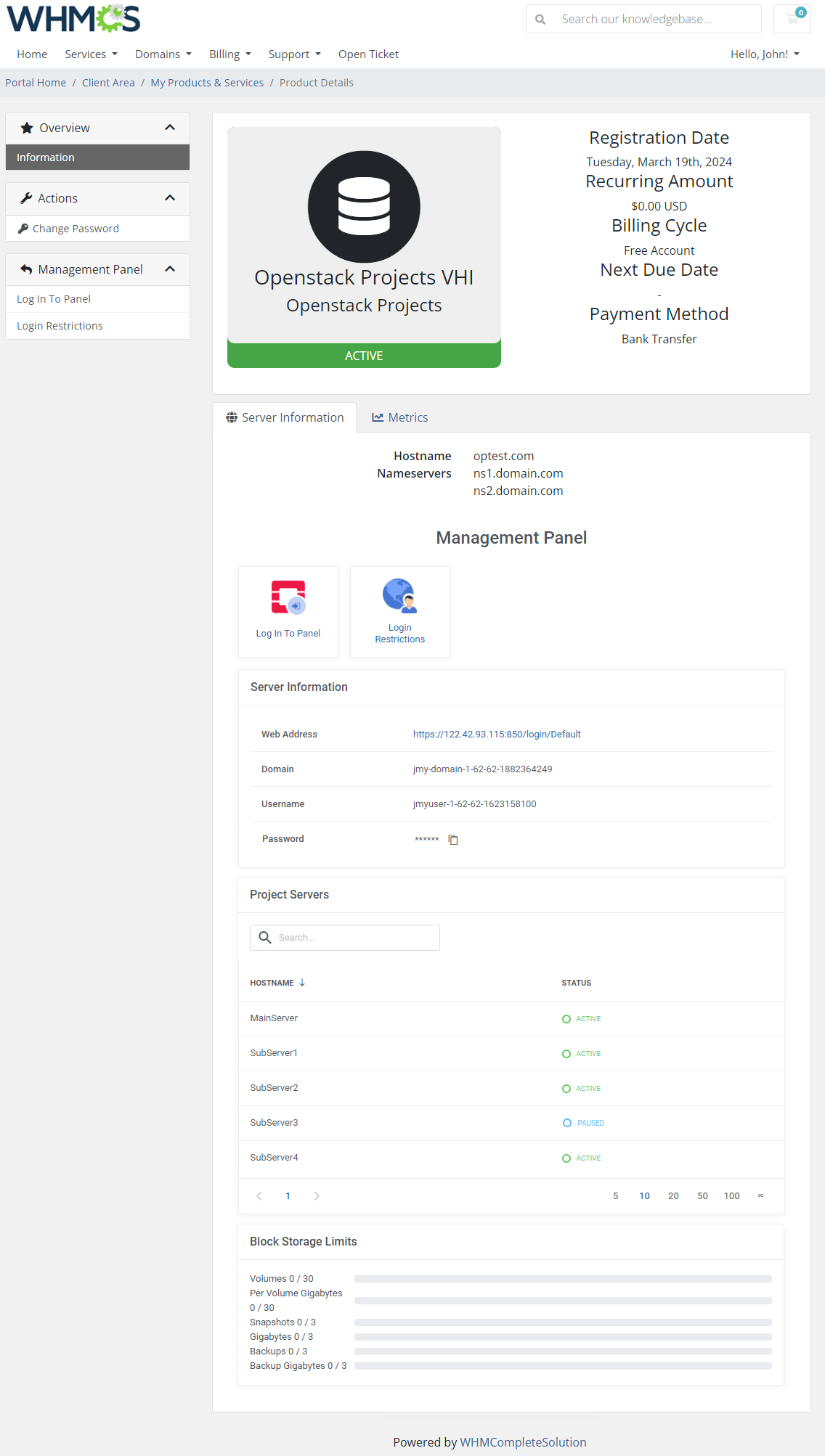
|
If the 'Login Restrictions feature is enabled for your product, you will also find an additional quick access shortcut.
|
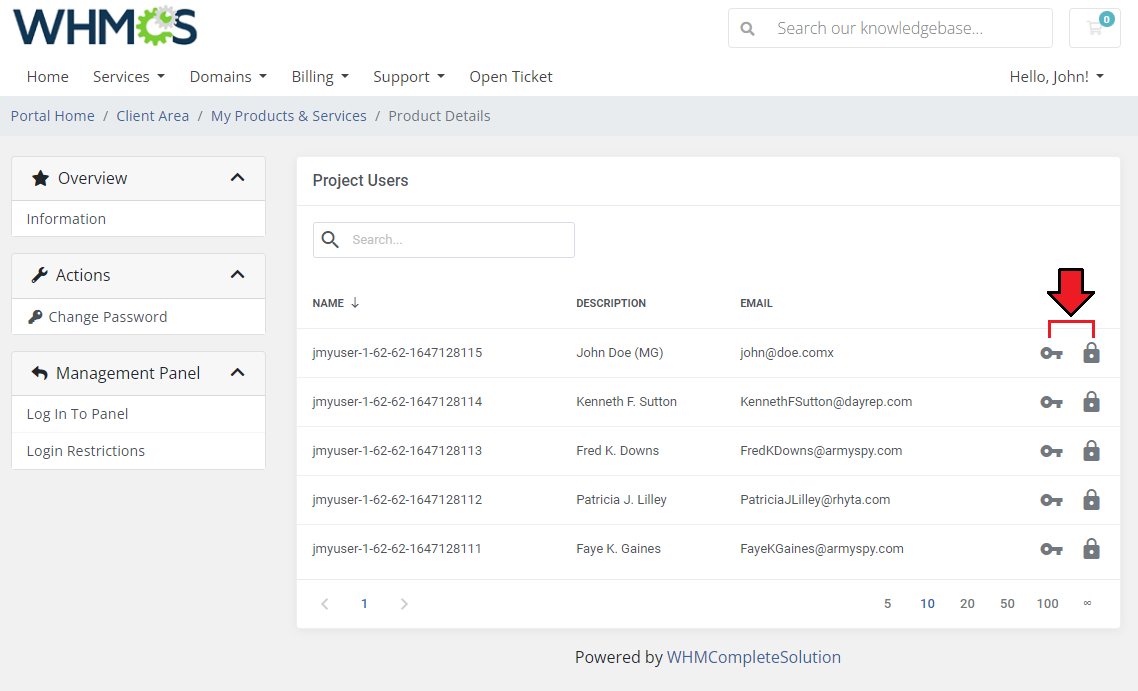
|
[edit] OpenID Configuration (VHI)
[edit] Customer Domain
| Follow the below instruction step by step to allow adding OpenID configuration automatically: 1. Configure OpenID in WHMCS, read the following article to learn how to proceed. ### VHI ACCESS DETAILS export VINFRA_PORTAL= export VINFRA_USERNAME= export VINFRA_PASSWORD="" export VINFRA_PROJECT="" ### WHMCS OPENID CONFIGURATION ISSUER="" CLIENT_ID="" CLIENT_SECRET="" 3. Move to the product 'Module settings' → 'Module Custom Shell Hooks' section. There add content to the 'Create' and ' Terminate' actions, for example: /home/yourWHMCS/vhi-integration/vinfra-cmd -d {$customfields.DomainName} -a create -n {$customfields.DomainName}
Terminate: /home/yourWHMCS/vhi-integration/vinfra-cmd -d {$customfields.DomainName} -a delete -n {$customfields.DomainName}
|
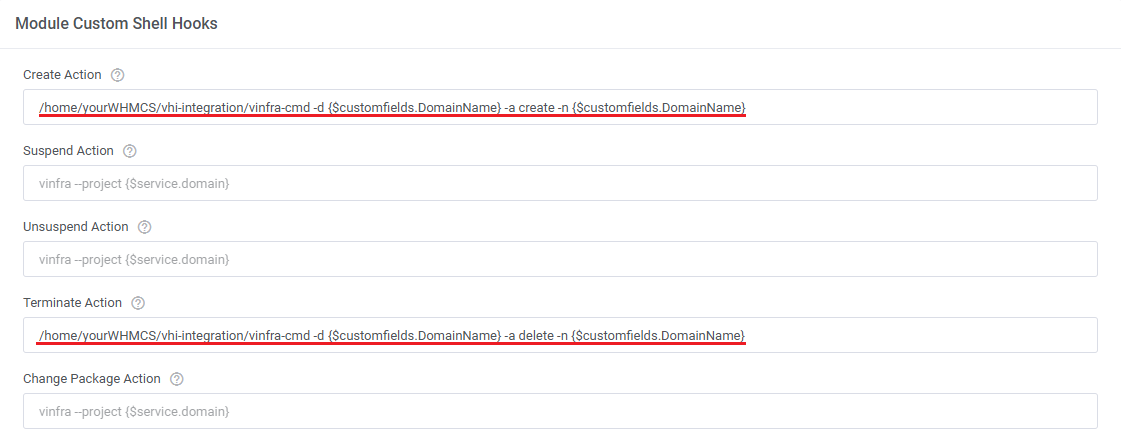
|
| 4. Again, in the 'Module Settings → 'Configuration' → 'Default Domain' select the Create New One option. |
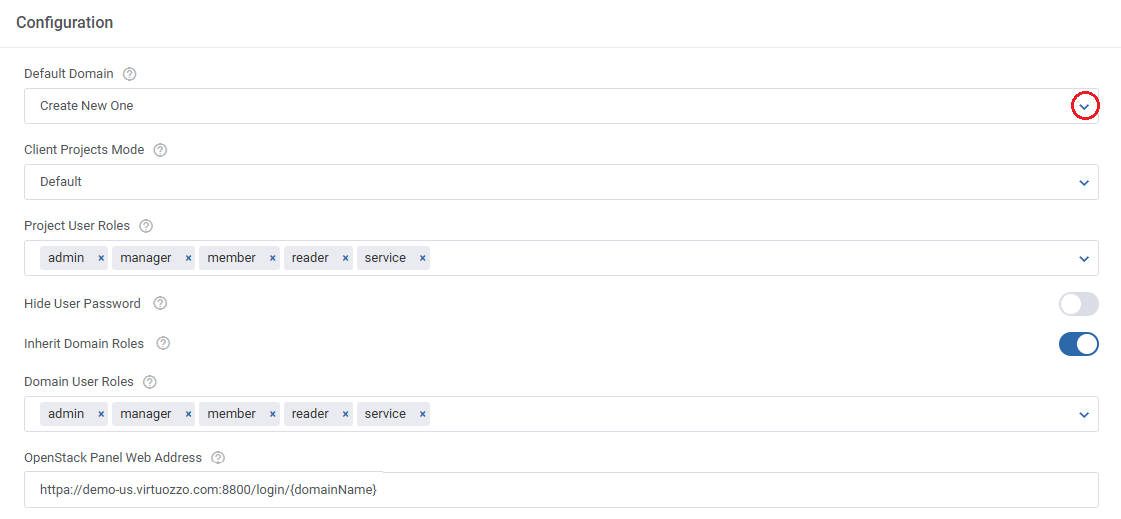
|
|
5. Run 'Create' module command. Important: You must have the vinfra program installed in /usr/bin catalog. Please contact the Virtuozzo team to get it. |
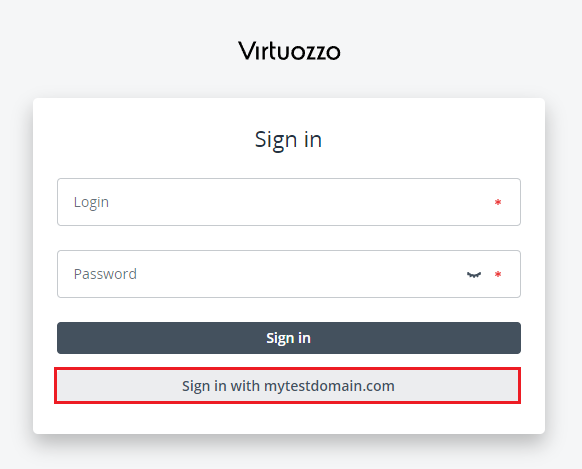
|
| Additional steps required:
1. OpenID Connect → Authorized Redirect URIs. Type in the VHI address that connects to your WHMCS, use the formula: https://VHI_DOMAIN:8800 and/or https://VHI_DOMAIN:8800/api/v2/login/idp/ |
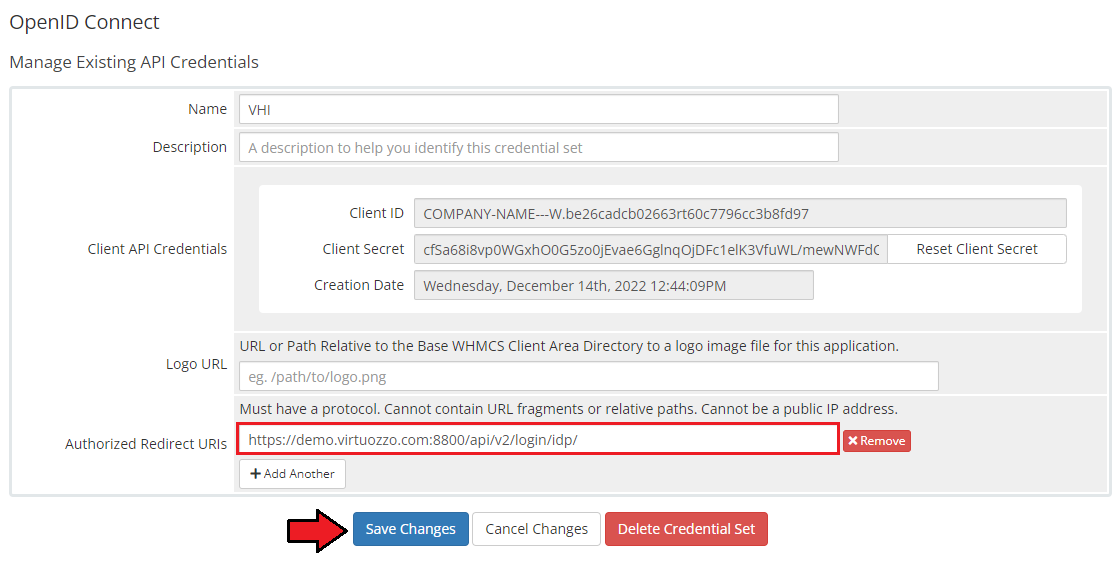
|
2. Add the below lines to the .htaccess file:
Order allow,deny Allow from 138.128.150.246 Allow from 192.168.5.91 satisfy any
RewriteEngine On RewriteRule ^.well-known/openid-configuration ./oauth/openid-configuration.php [L,NC] |
| 3. Domain and WHMCS system URLs must have https protocol: |
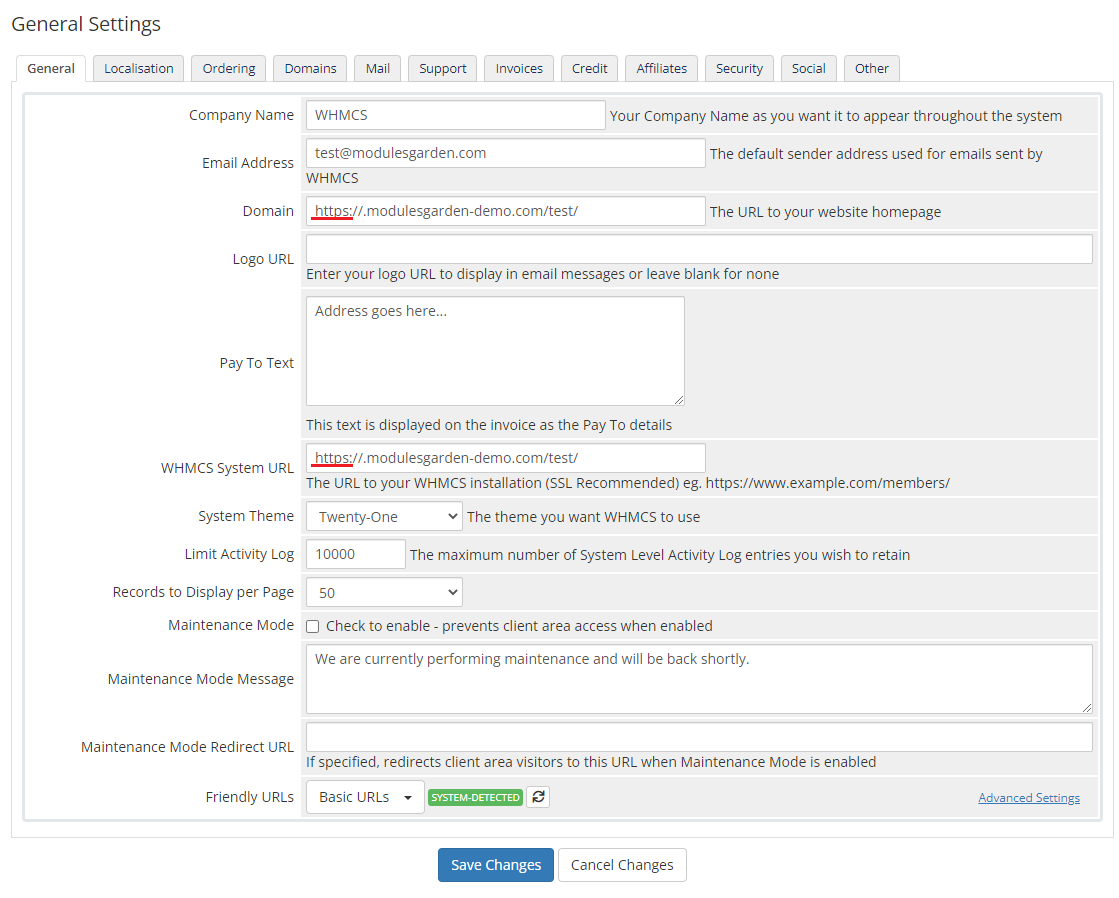
|
| 4. Enter the login link into the OpenStack Panel web address |
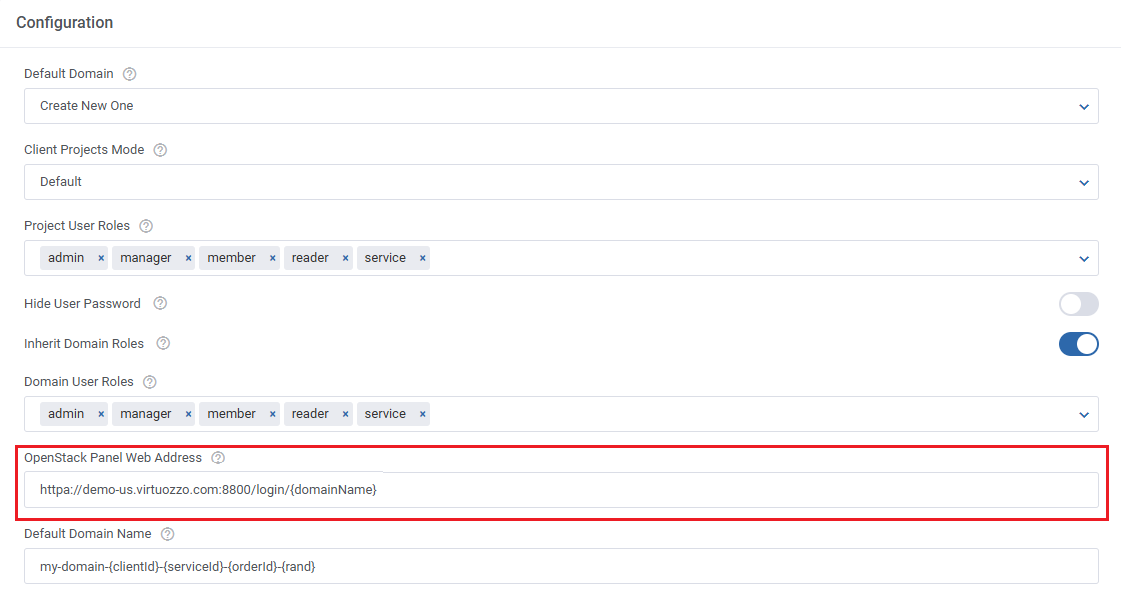
|
[edit] Predefined Domain
| Follow the below instruction step by step to use a predefined domain for OpenID configuration: 1. Configure OpenID in WHMCS, read the following article to learn how to proceed. |
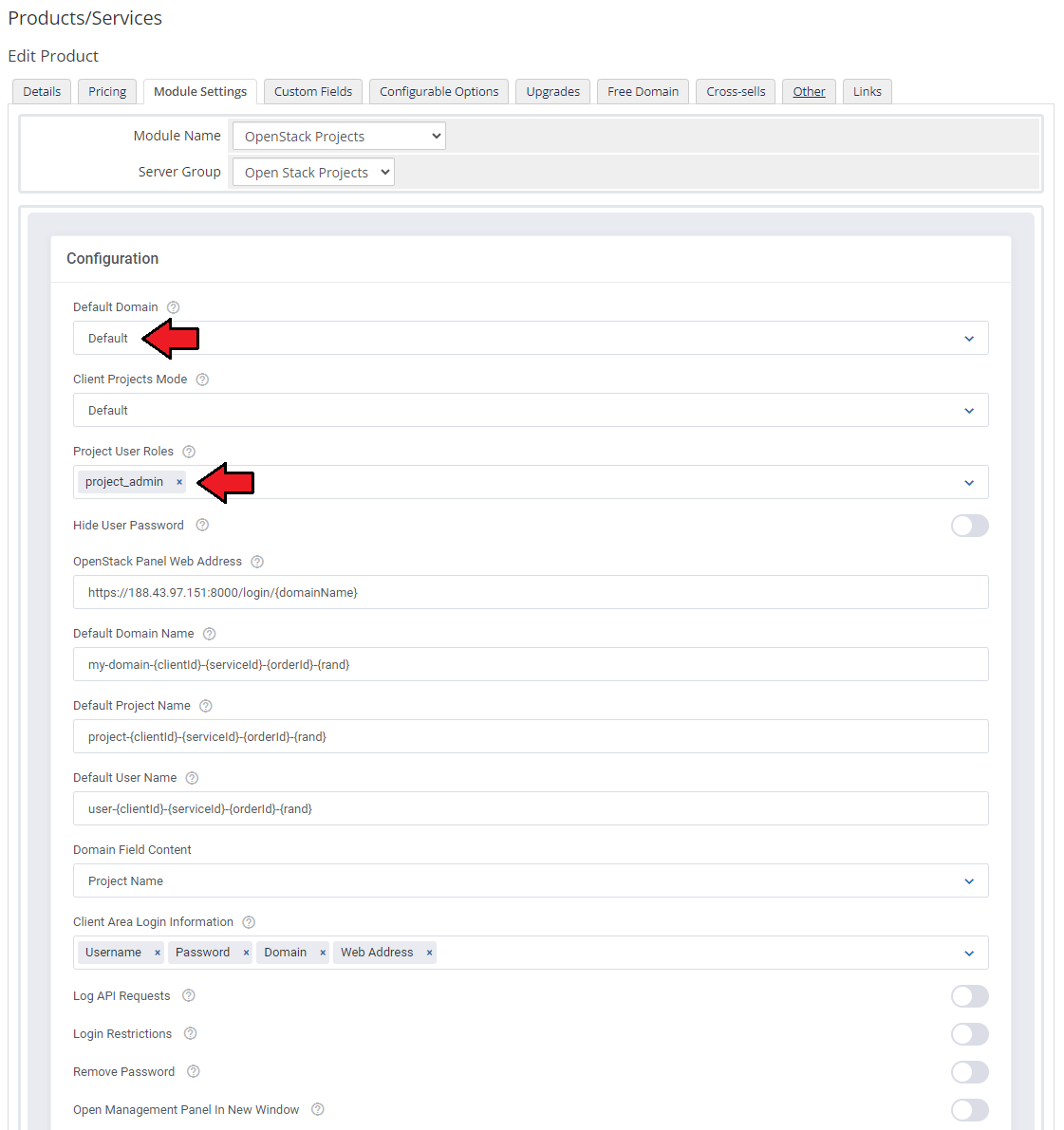
|
| 3. Configure OpenID in VHI. Remember to include the same domain that has been used during product configuration in WHMCS after the '=' symbol in 'Metadata URL'. |
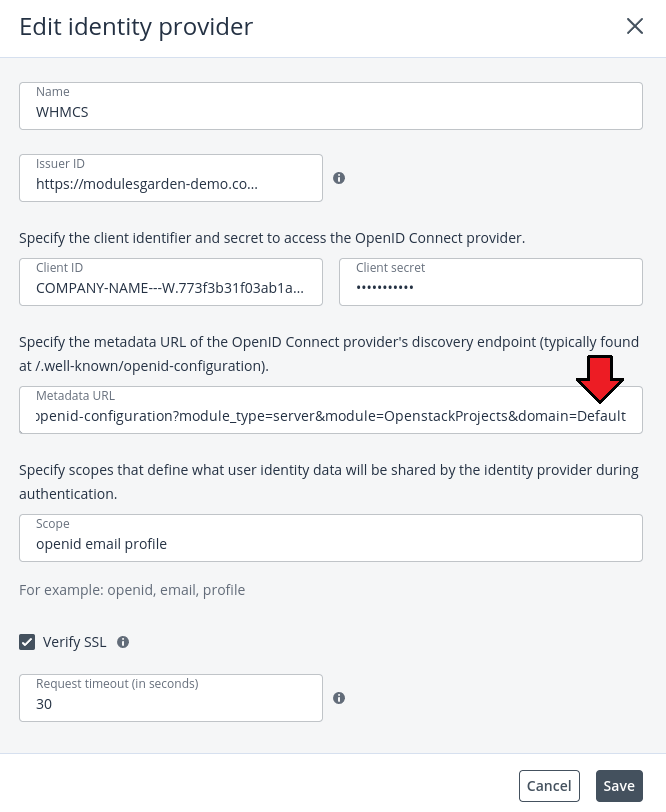
|
| 4. Select 'Authorization Code Flow'. |
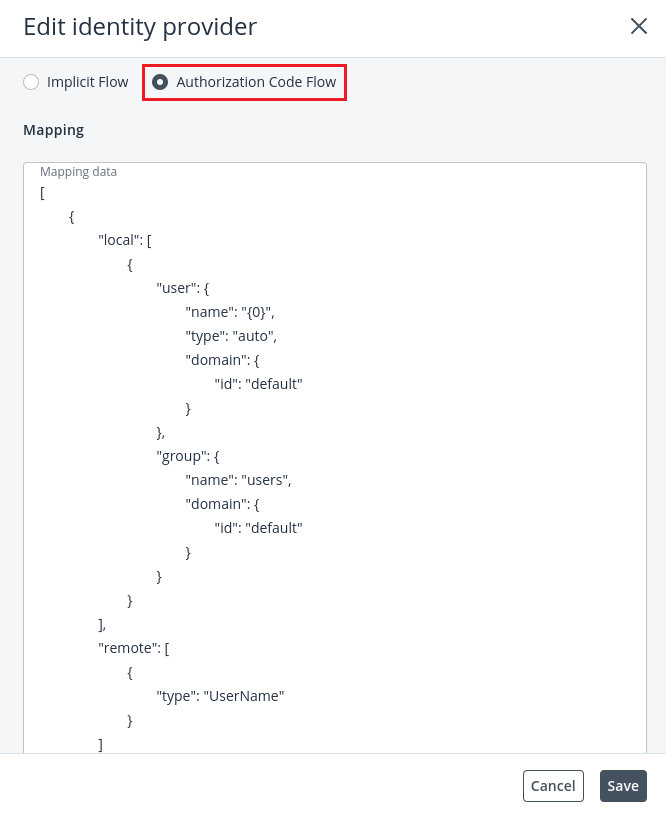
|
[edit] Custom Scope Configuration
| Due to differences in policy configurations across various OpenStack environments, each API request now has a configurable authentication method. This configuration is managed through the auth.yml file located in app/Config/auth.yml. The file contains settings for two user types: System Admin and Domain Admin.The appropriate configuration is loaded based on the server settings. |
[edit] Configuration Structure
The auth.yml file is structured into two sections:
Each section contains:
|
[edit] Exemplary Configuration
System Admin Configuration
systemAdmin:
default:
authUrl: "{$server.authUrl}"
auth:
identity:
methods:
- "password"
password:
user:
name: "{$server.username}"
domain:
name: "{$server.domain}"
password: "{$server.password}"
scope:
project:
id: "{$server.projectId}"
"network.v2.actions.floating_ips.get.get":
auth:
identity:
methods:
- "password"
password:
user:
name: "{$server.username}"
domain:
name: "{$server.domain}"
password: "{$server.password}"
scope:
project:
id: "{$service.projectId}"
domain:
name: "{$service.domainName}"
Domain Admin Configuration domainAdmin:
default:
authUrl: "{$server.authUrl}"
auth:
identity:
methods:
- "password"
password:
user:
name: "{$server.username}"
domain:
name: "{$server.domain}"
password: "{$server.password}"
scope:
project:
id: "{$server.projectId}"
domain:
name: "{$server.domain}"
"identity.v3.actions.users.delete.delete":
auth:
identity:
methods:
- "password"
password:
user:
name: "{$server.username}"
domain:
name: "{$server.domain}"
password: "{$server.password}"
scope:
domain:
name: "{$server.domain}"
|
Explanation:
|
[edit] Adding Custom Authentication Scope
| If a specific API request is not functioning as expected due to scope limitations, a custom authentication method can be defined. To do this:
1. Enable API logging in the module settings: Log API Requests. |
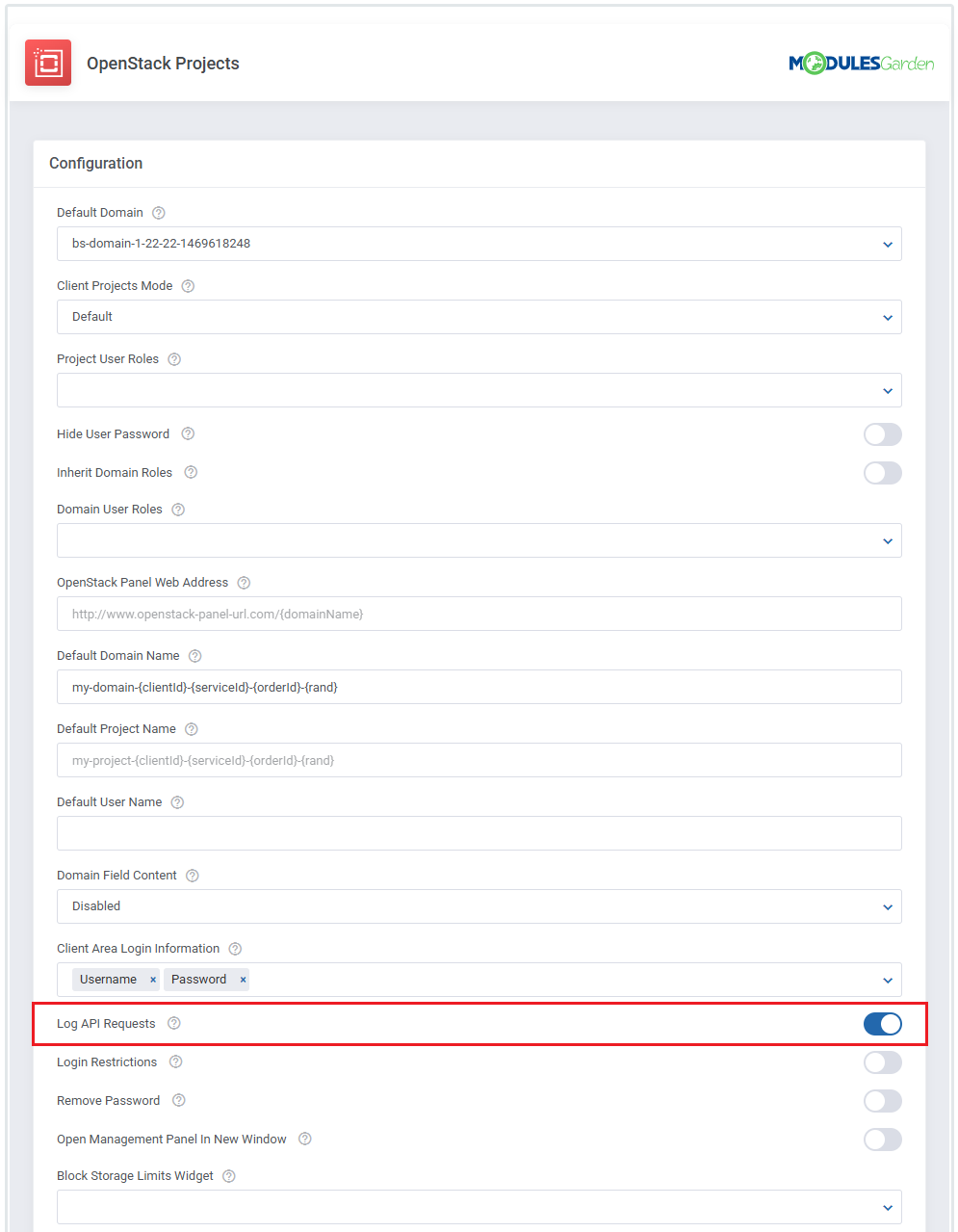
|
| 2. Identify the problematic API request from the logs. |
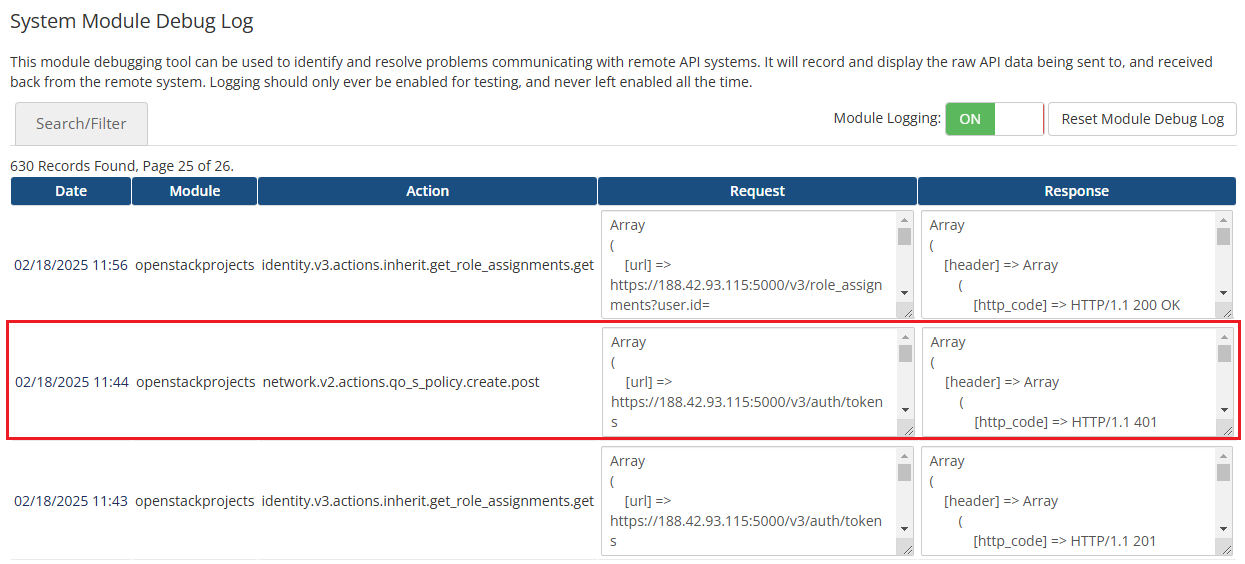
|
| 3. Add a new authentication scope to auth.yml for the relevant user type. To add custom authentication for the domainAdmin:
"network.v2.actions.qo_s_policy.create.post":
auth:
identity:
methods:
- "password"
password:
user:
name: "{$server.username}"
domain:
name: "{$server.domain}"
password: "{$server.password}"
scope:
project:
id: "{$service.projectId}"
domain:
name: "{$service.domainName}"
After this modification, the request |
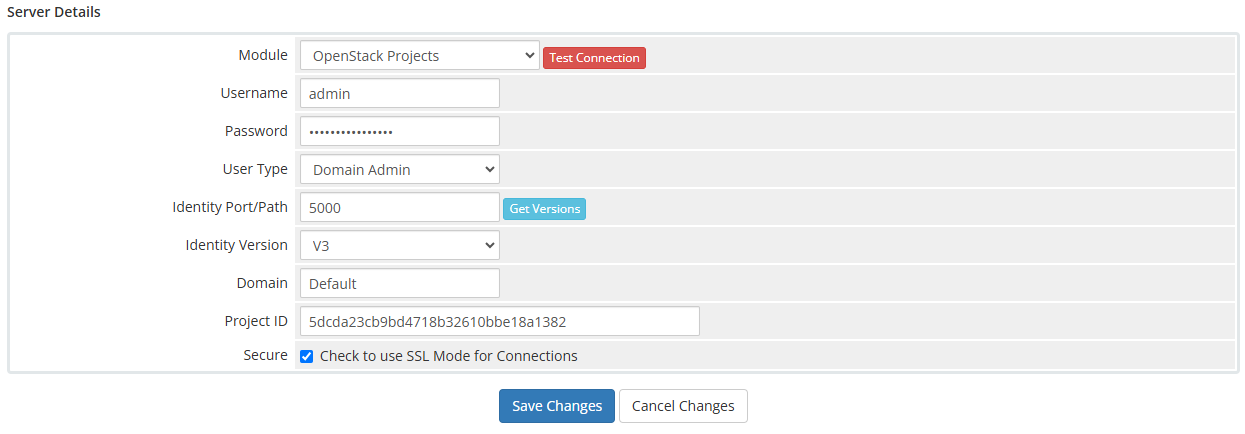
|
[edit] Replacement Fields
| In the auth.yml configuration, several replacement fields dynamically pull values from the OpenStack environment and server configuration: |
| Replacement Fields | Description | |
|---|---|---|
| 1. | $service.password
|
Password from the service. |
| 2. | $service.username
|
Username from the service. |
| 3. | $service.domainName
|
Domain name from the DomainName field.
|
| 4. | $service.domainId
|
Domain ID from the DomainId field.
|
| 5. | $service.projectId
|
Project ID from the ProjectId field.
|
| 6. | $server.host
|
Server IP address. |
| 7. | $server.protocol
|
HTTP/HTTPS based on server settings. |
| 8. | $server.username
|
Username from the server configuration. |
| 9. | $server.password
|
Password from the server configuration. |
| 10. | $server.domain
|
Domain from the server configuration. |
| 11. | $server.projectId
|
Project ID from the server configuration. |
| 12. | $server.userType
|
User type (Domain Admin / System Admin).
|
| 13. | $server.identityVersion
|
Identity version from server configuration. |
| 14. | $server.identityPath
|
Identity path from the server configuration. |
[edit] Manual Configuration in File
The configuration.yml file located at /yourWHMCS/modules/servers/OpenstackProjects/app/Config/configuration.yml allows you to configure advanced options:
|
| 1. Usage metrics calculation Metrics can be calculated based on total or average usage for a given period. Modify this in configuration.yml by setting the averageBilling option:
|

|
| 2. Disabling usage metrics If you have a large database, disabling usage metrics may improve performance. Set the disableUsageMetrics option:
disableUsageMetrics: true # Disables usage metrics |

|
| 3. Disabling module termination option To completely disable the termination function in the module, set the disableTerminate: option in the configuration.yml file to true:
disableTerminate: 'true' # Disables termination |

|
[edit] Tips
| 1. The module supports OpenStack providers that grant access to the OpenStack API on system admin level. Make sure the account you use has sufficient permissions to manage projects and perform required actions through the API. For more details, see the OpenStack API documentation. |
| 2. Please remember that if you integrate OpenStack Projects For WHMCS with Advanced Billing For WHMCS, the cron task should be set no more than once for an hour. |
| 3. When using multiple OpenStack servers or products, keep in mind that the quotas configuration (quotas.json) is shared globally. To avoid issues during provisioning, make sure all linked servers support the same quota options or leave unsupported ones empty to skip them. |
[edit] Update Instructions
| An essential guidance through the process of updating the module is offered here. Before updating your OpenStack Projects For WHMCS module to version 1.8.0, it is strongly recommended to delete all files (excluding license.php) located in: /yourWHMCS/modules/servers/OpenStackProjects/. After a successful upgrade, please proceed to the product's module settings section to ensure a smooth transition. |
[edit] Upgrade Guide
| Seeking a solution that offers greater flexibility, customization tailored to your precise needs, and unrestricted availability? There is an option that not only proves to be cost-effective in the long run but also includes prioritized support services, making it a truly valuable investment. Opt for the Open Source version of your OpenStack Projects For WHMCS module to unlock these benefits. Follow a comprehensive guide covering the transition process, the advantages it brings, and step-by-step instructions on what to do next after the order has been successfully finalized. |
[edit] Common Problems
| 1. When you have problems with connection, check whether your SELinux or firewall does not block ports. |
| 2. If you encounter a connection error in the module settings: 'Error:Connection Error: No route to host (Action: GET https://compute-api.svc.vstoragedomain.:8784/v2.1/5dcda23cb9bd4718b32610bbe18a1382/os-availability-zone). Check WHMCS module log for more information' |